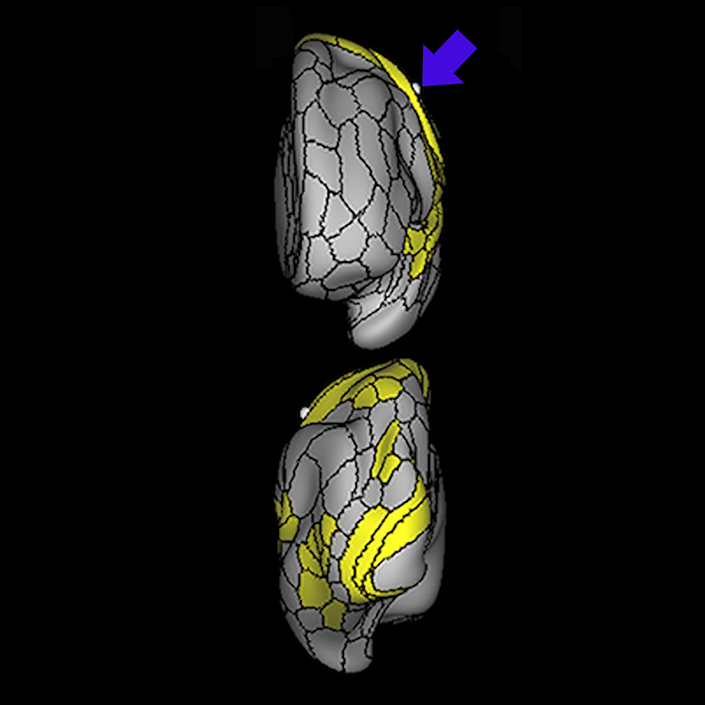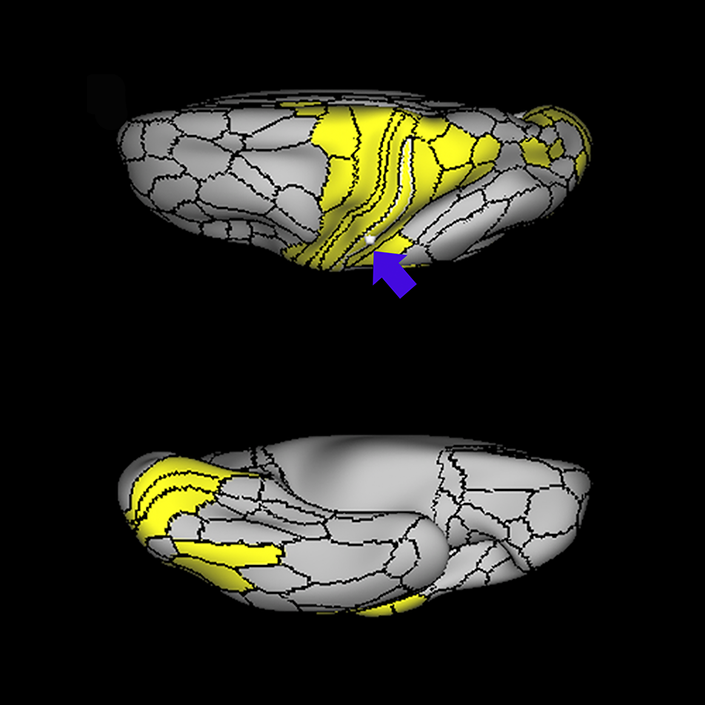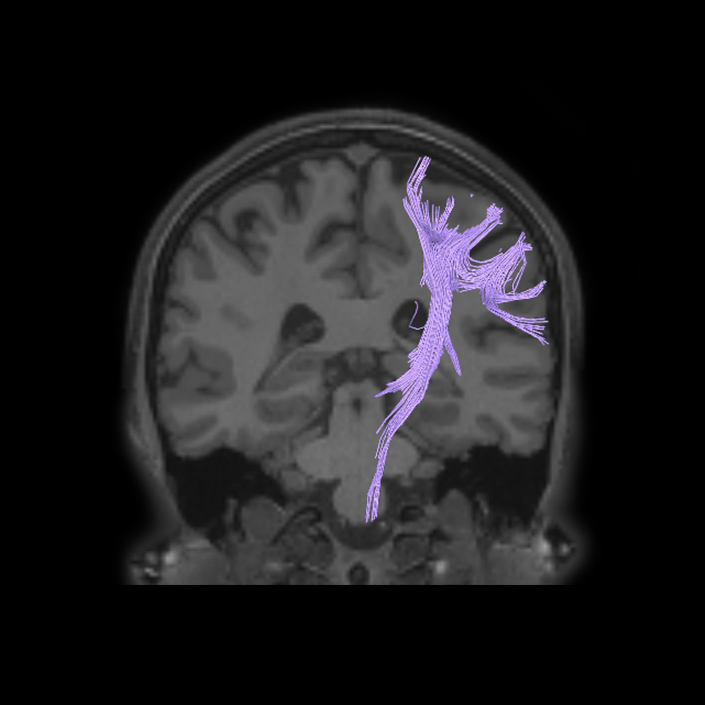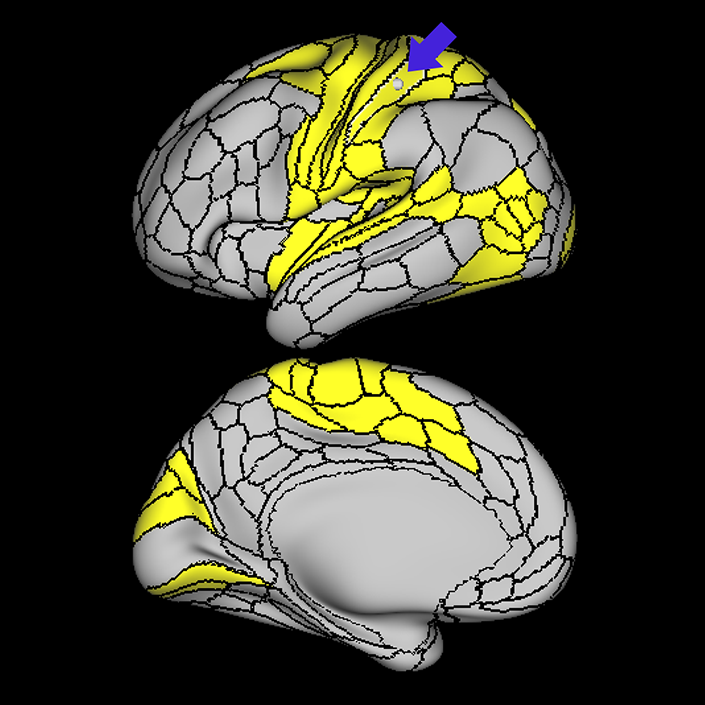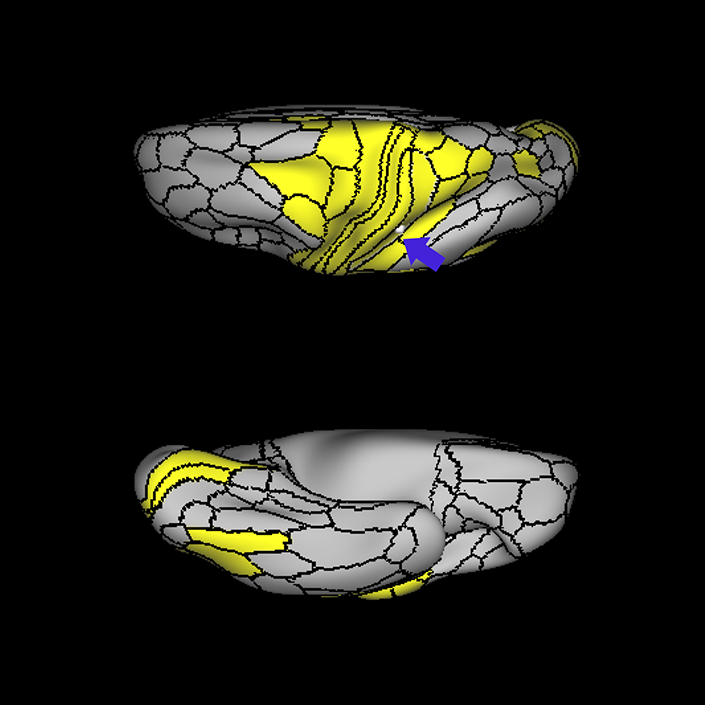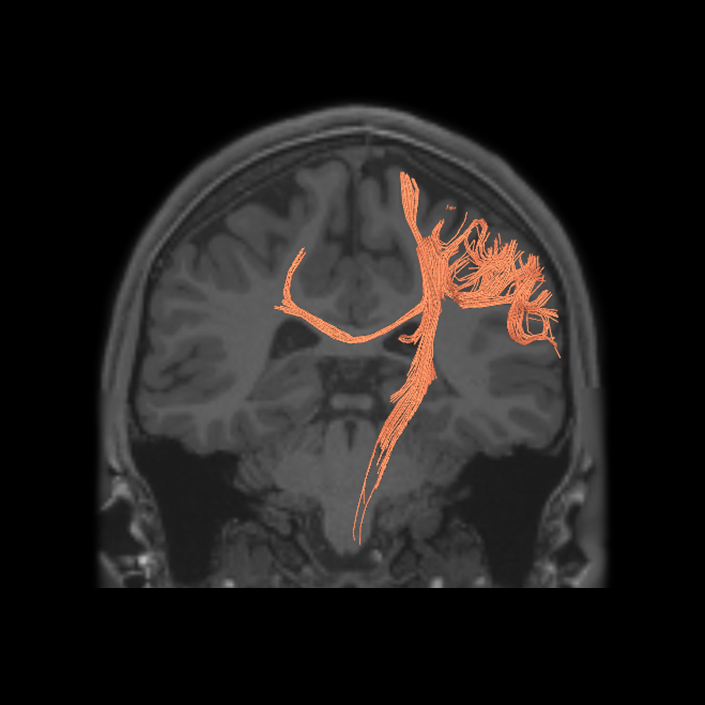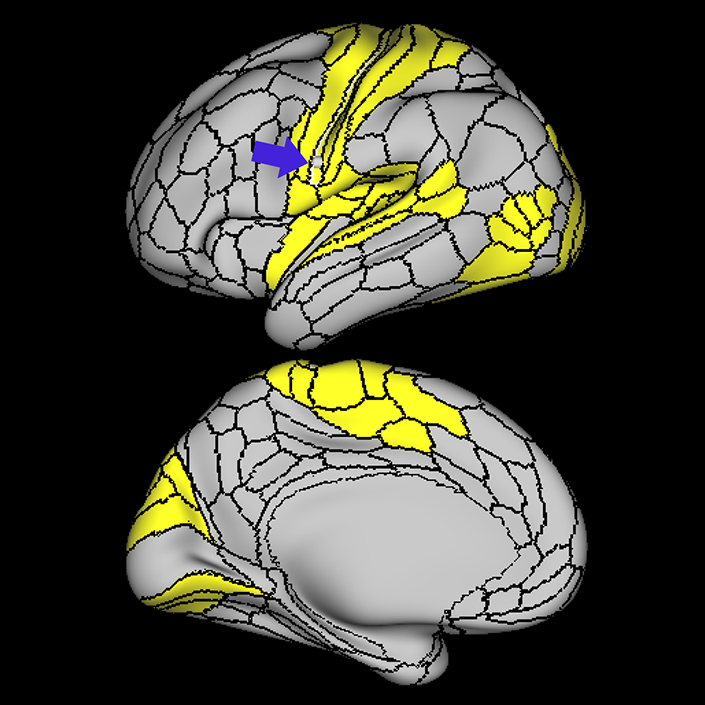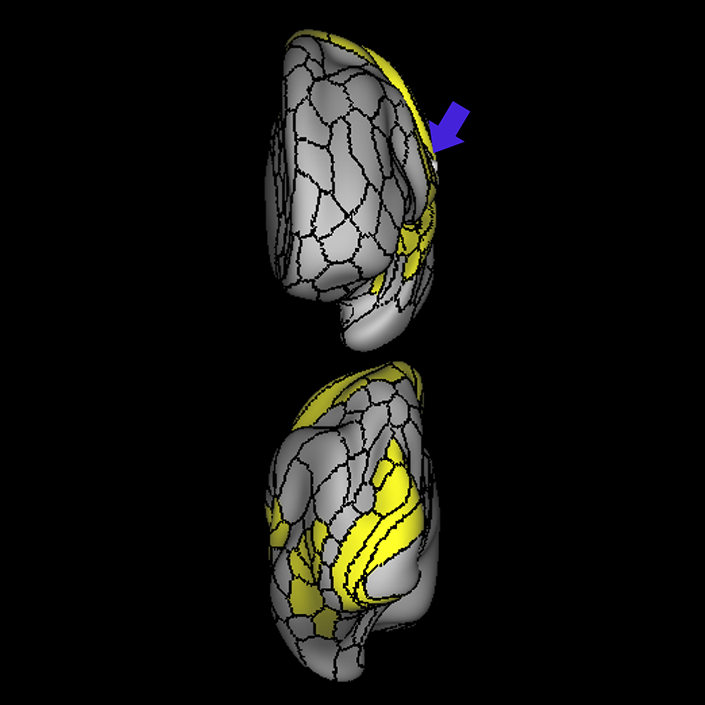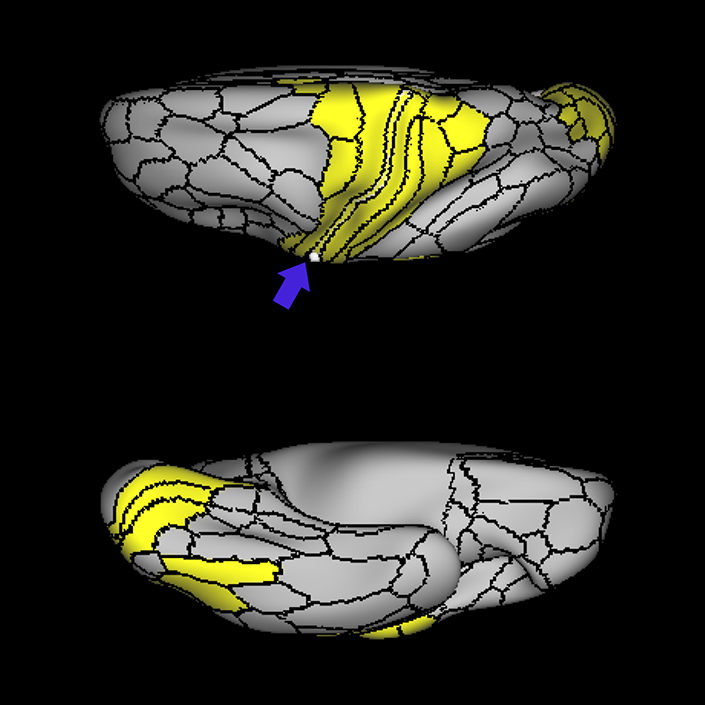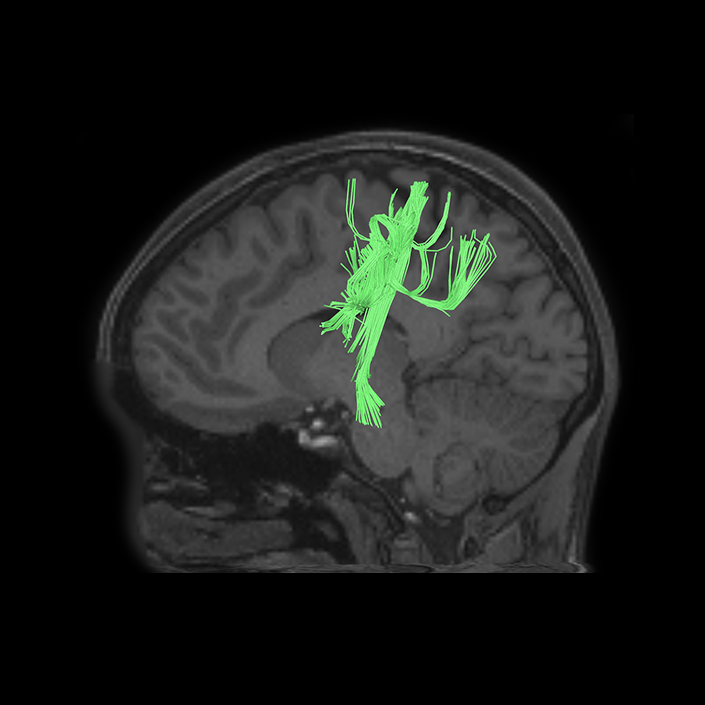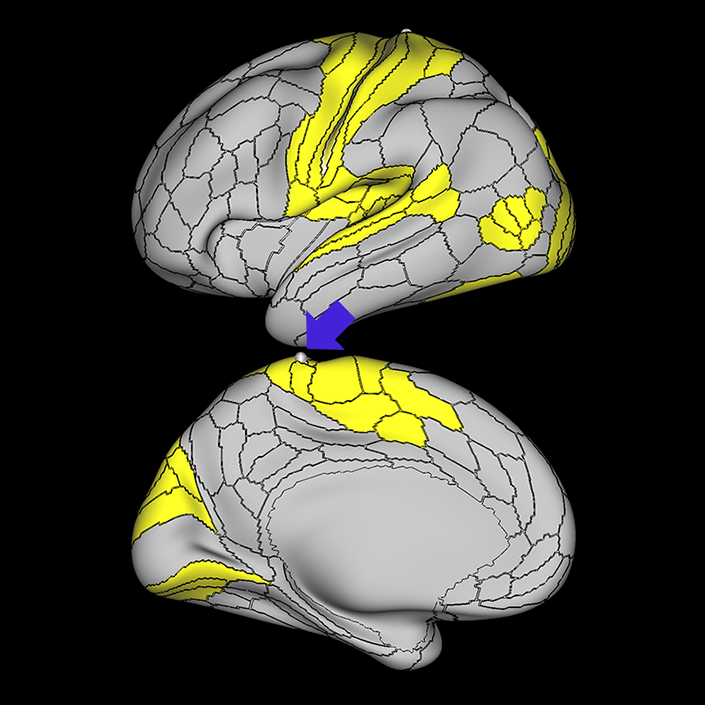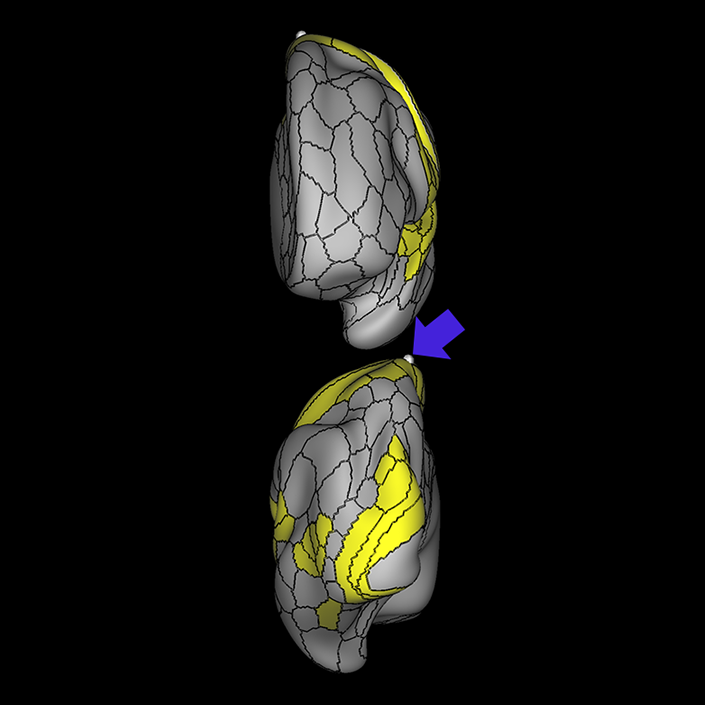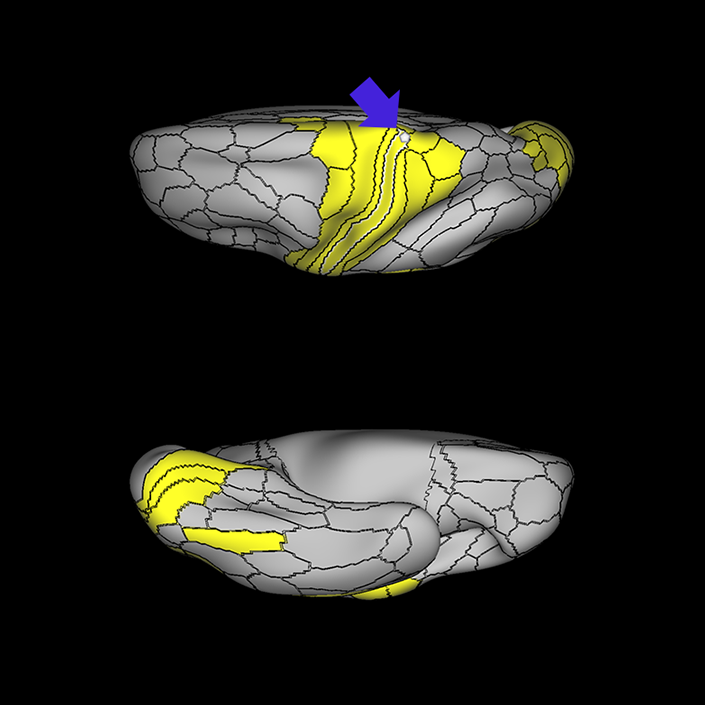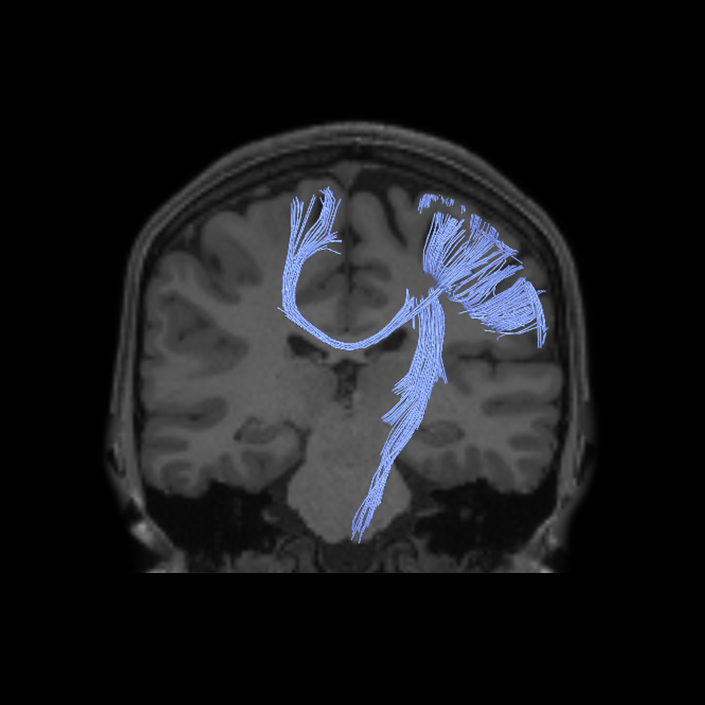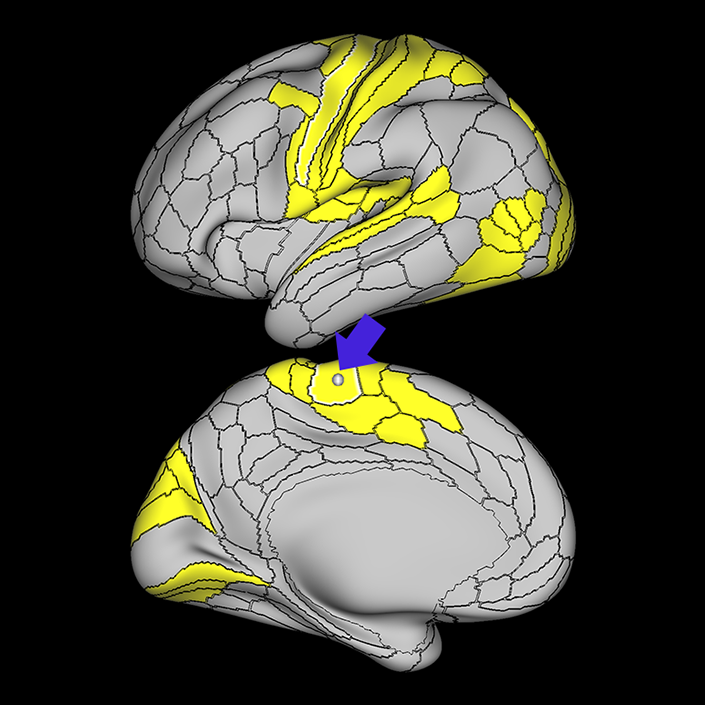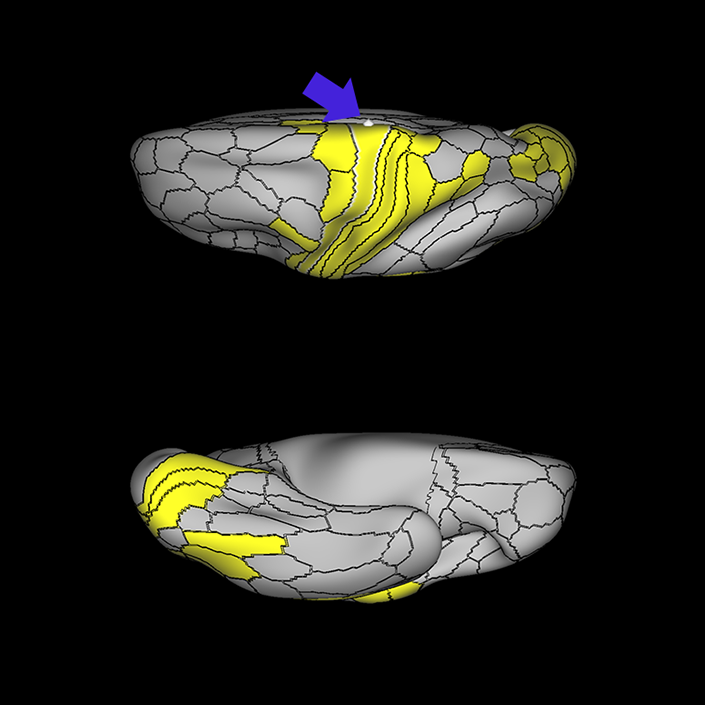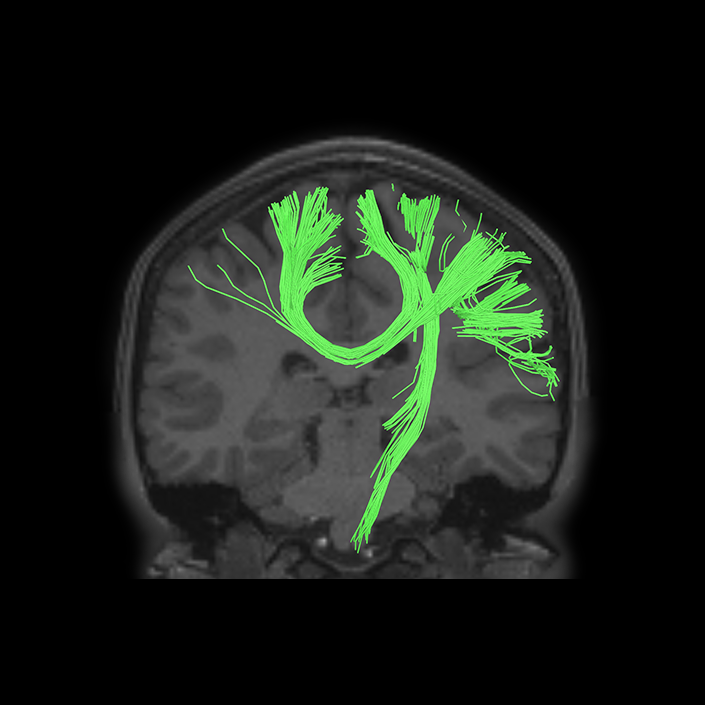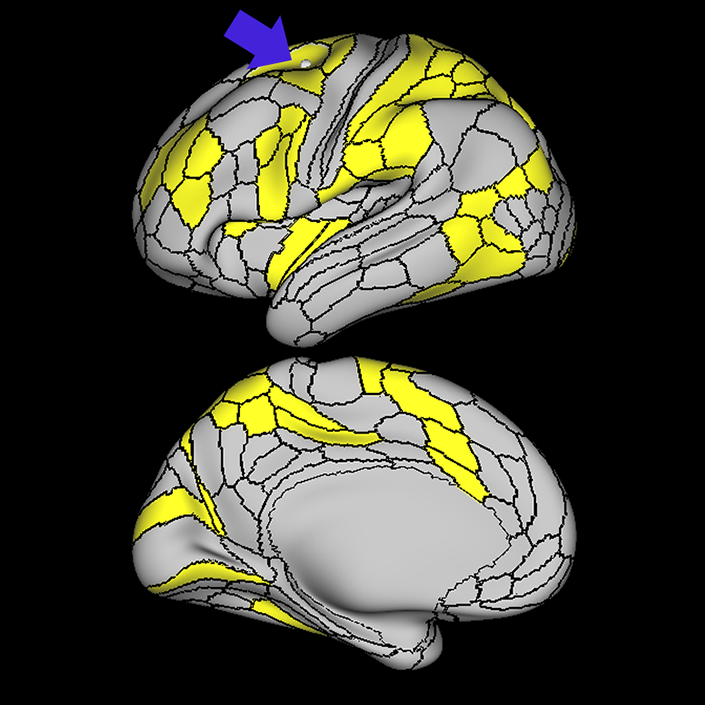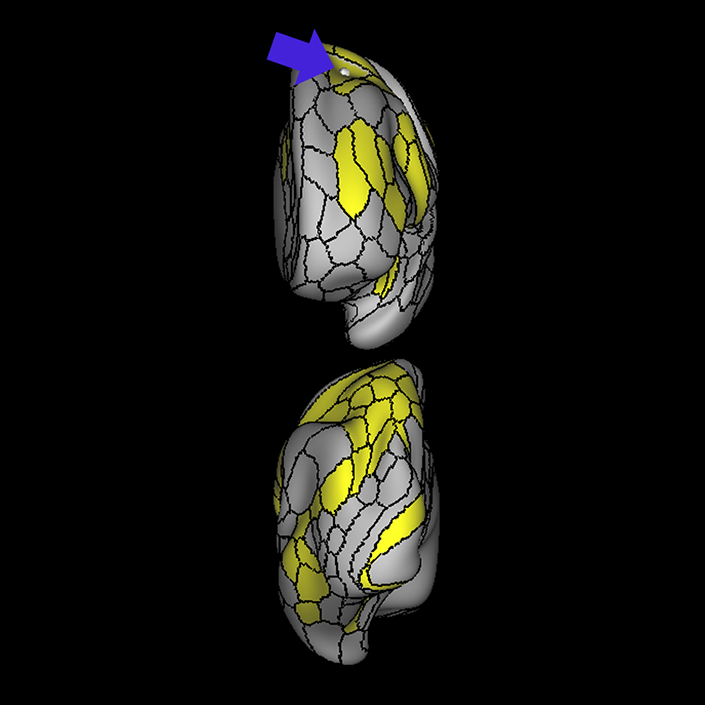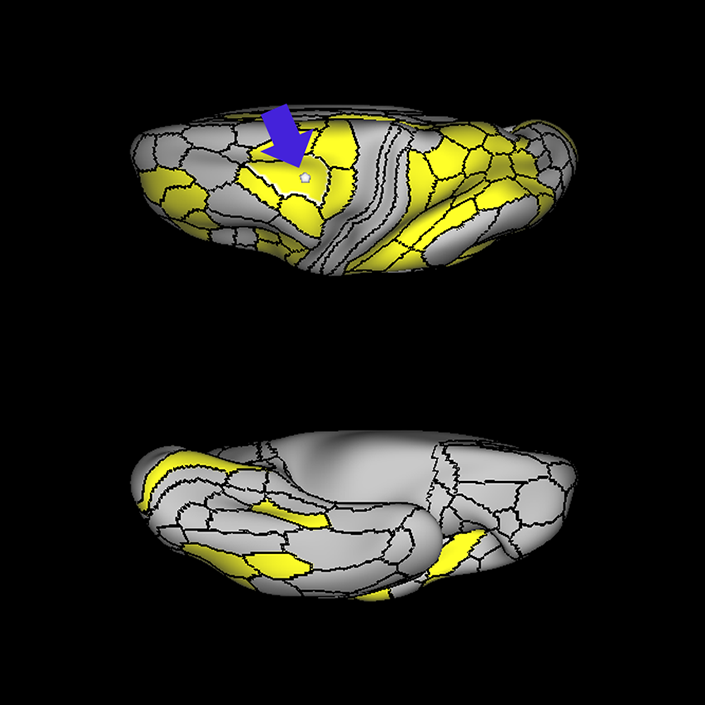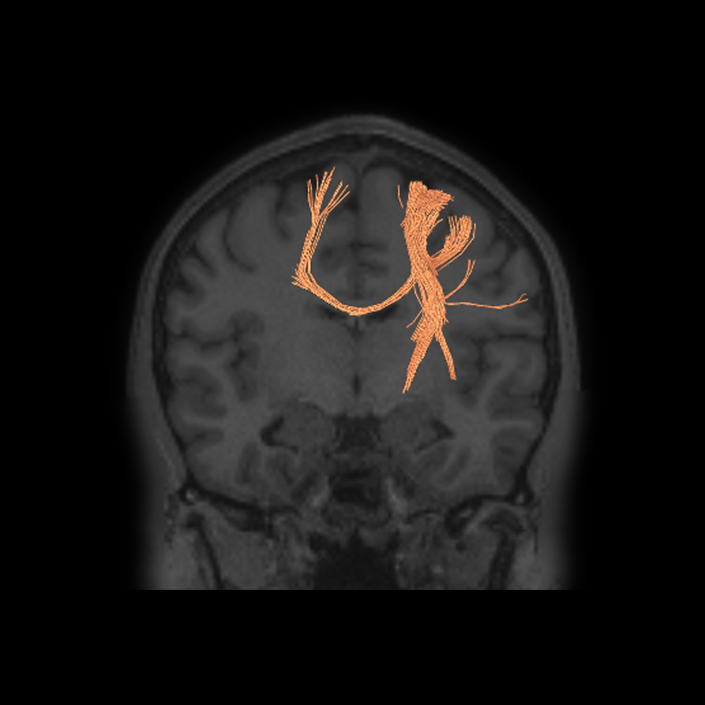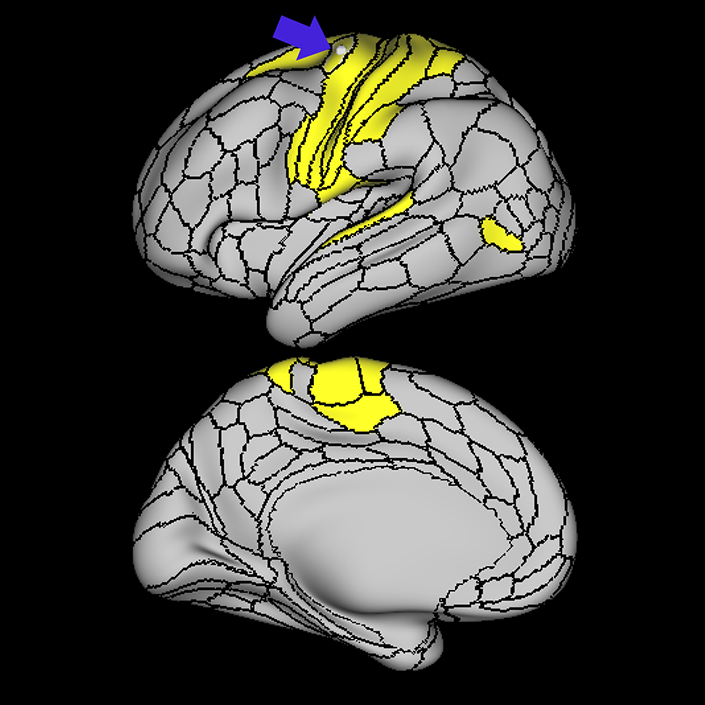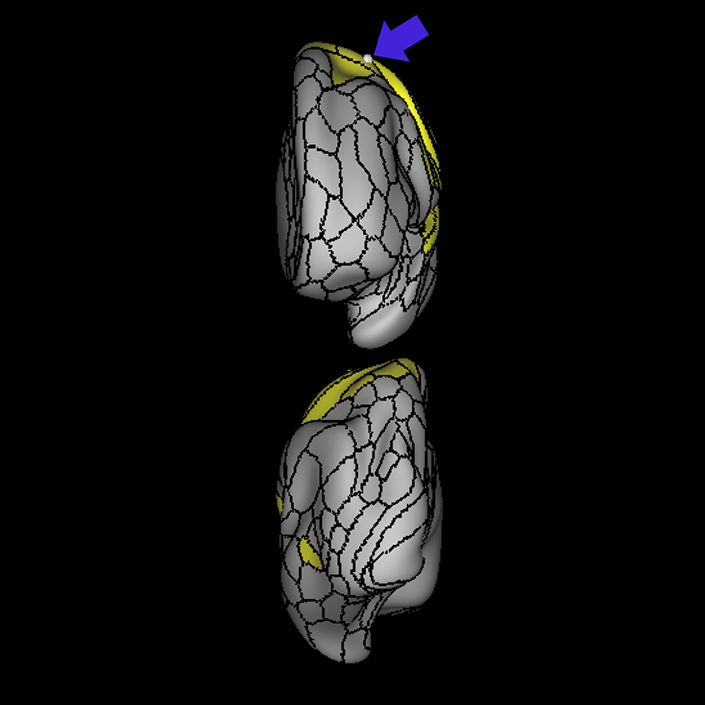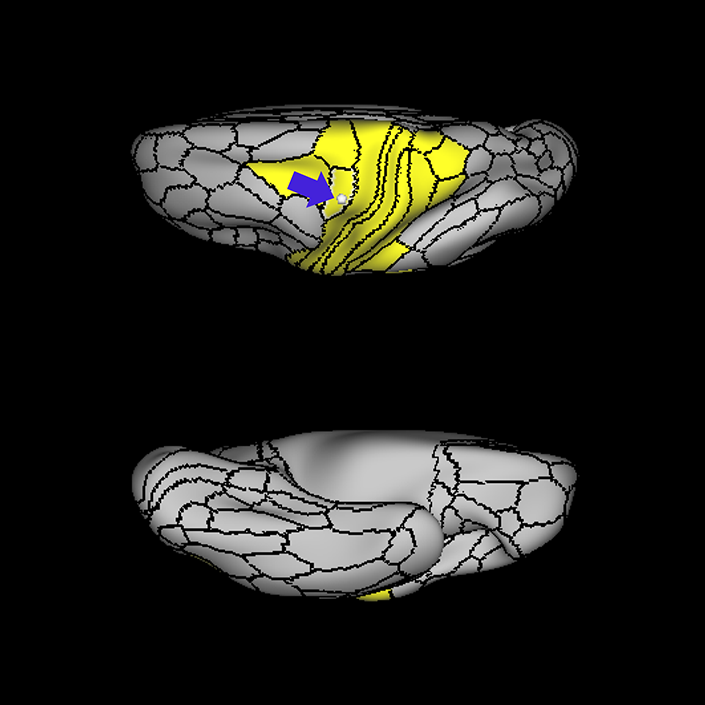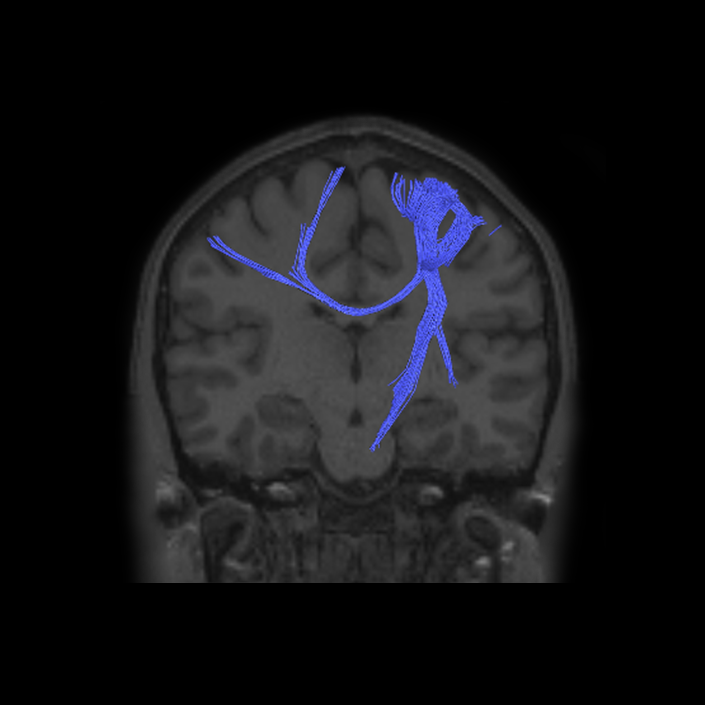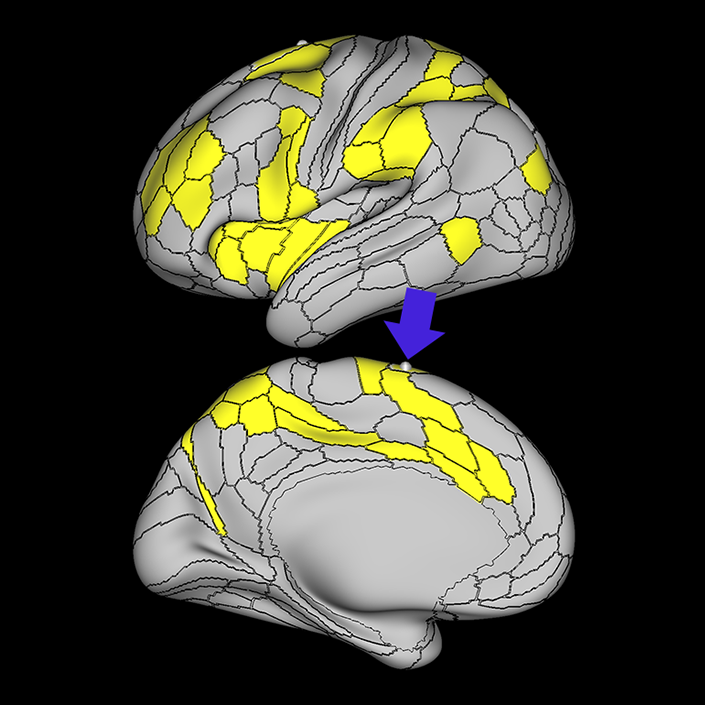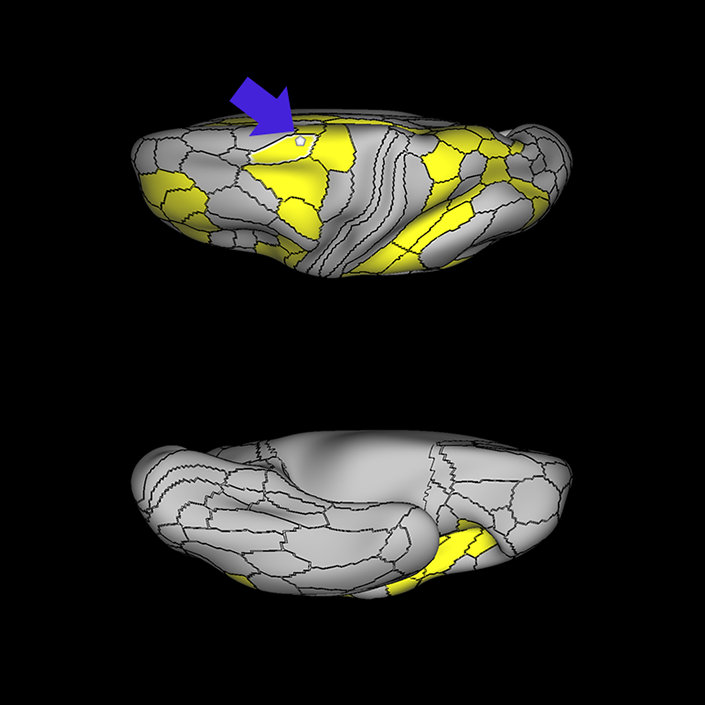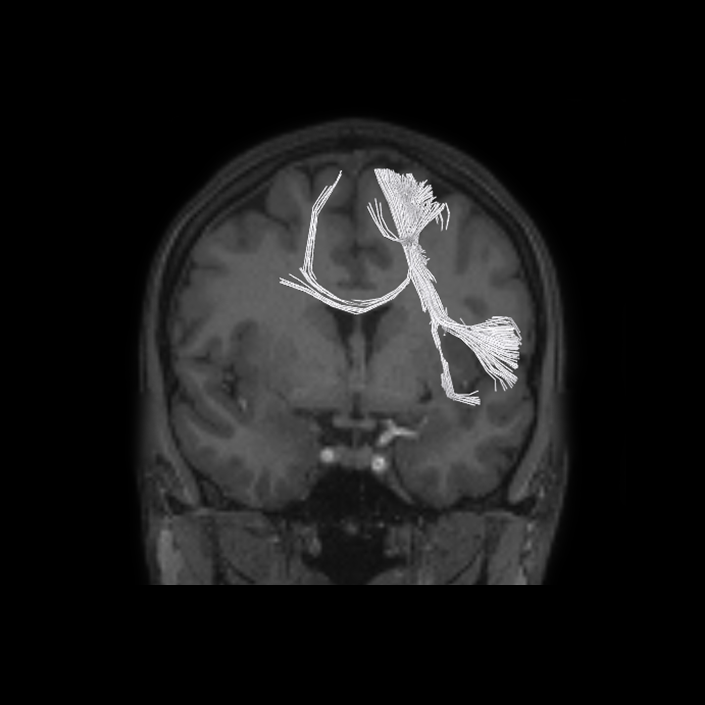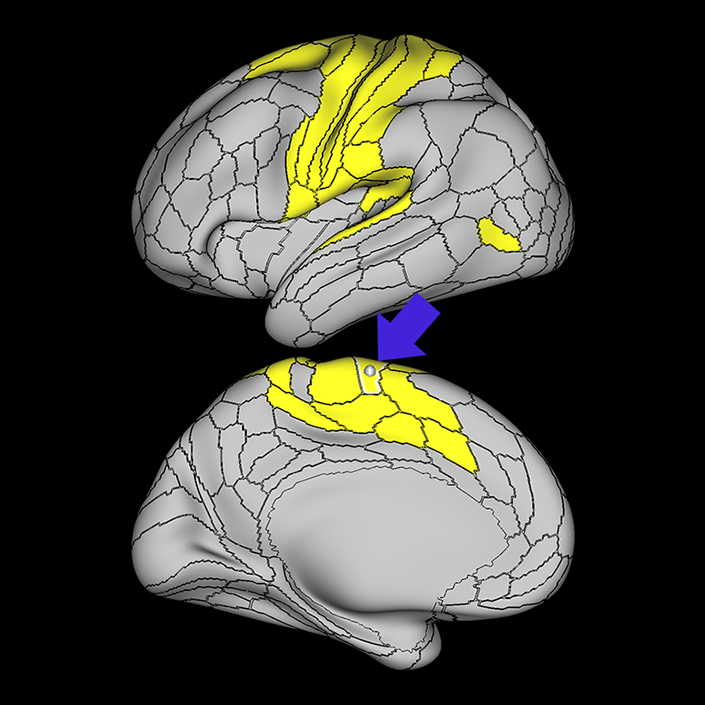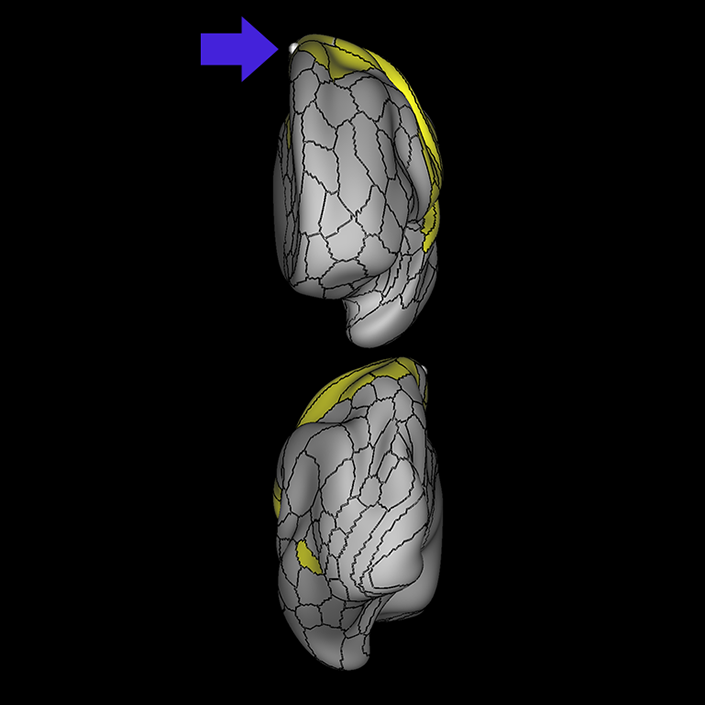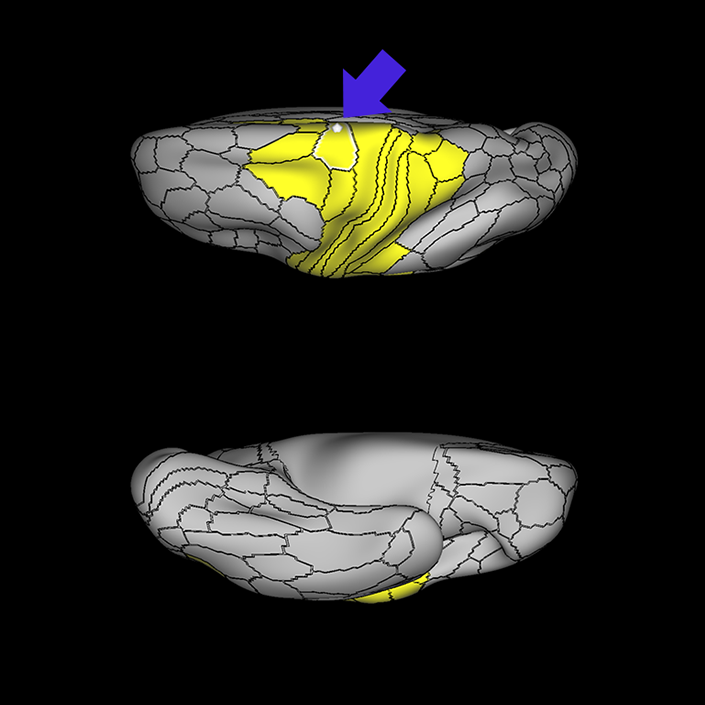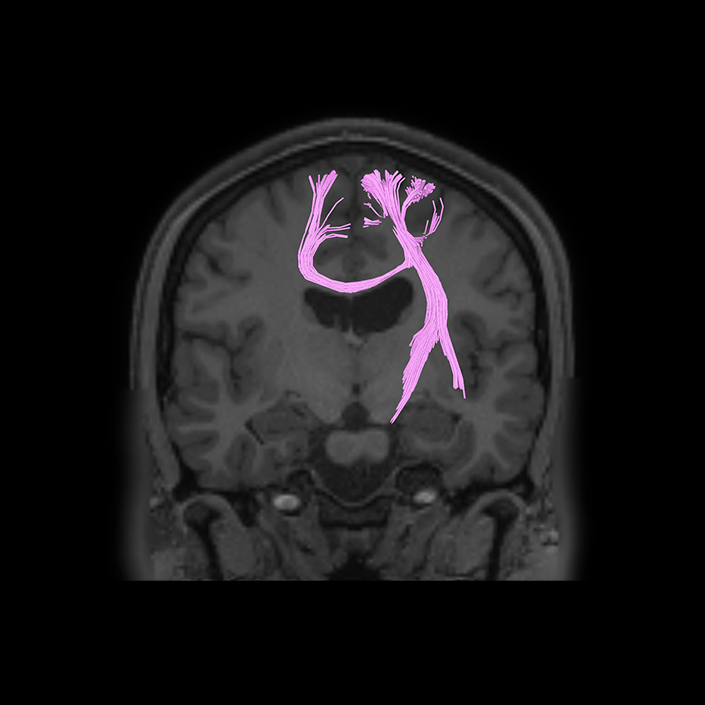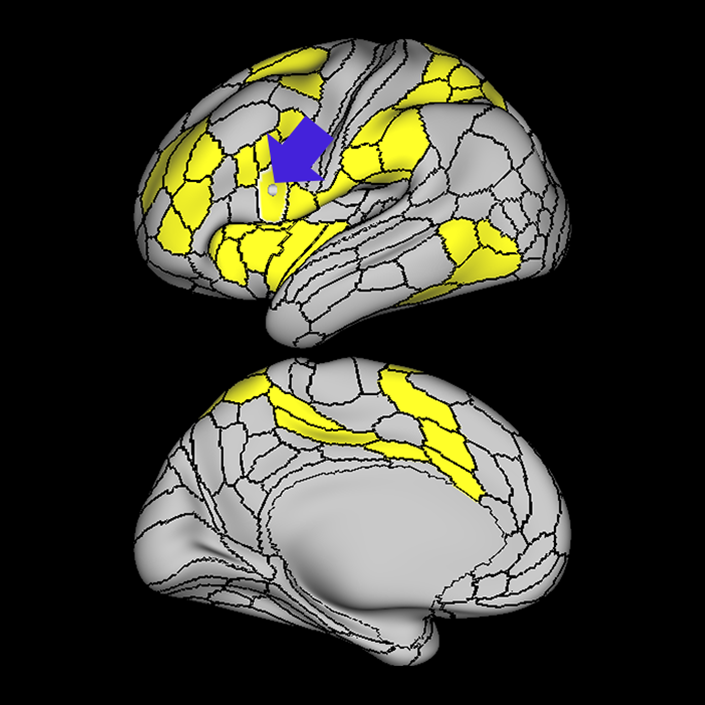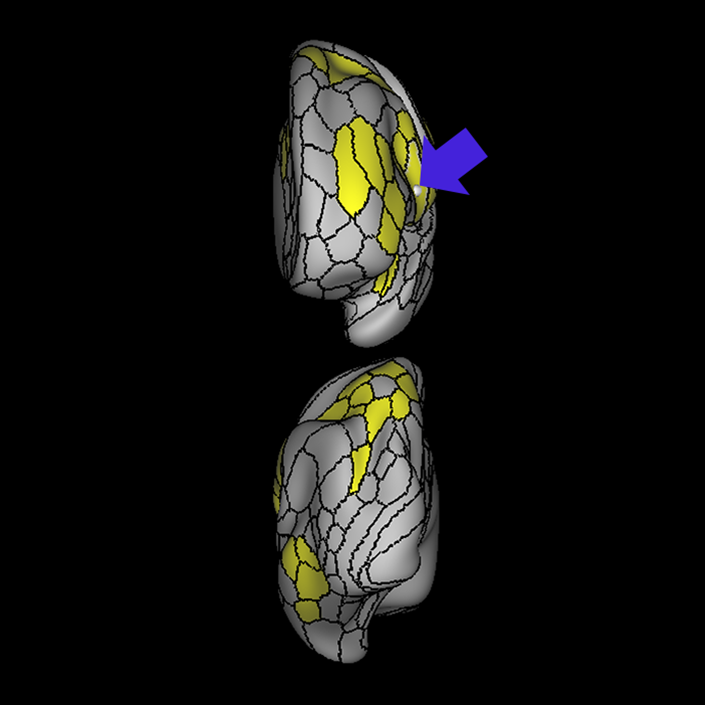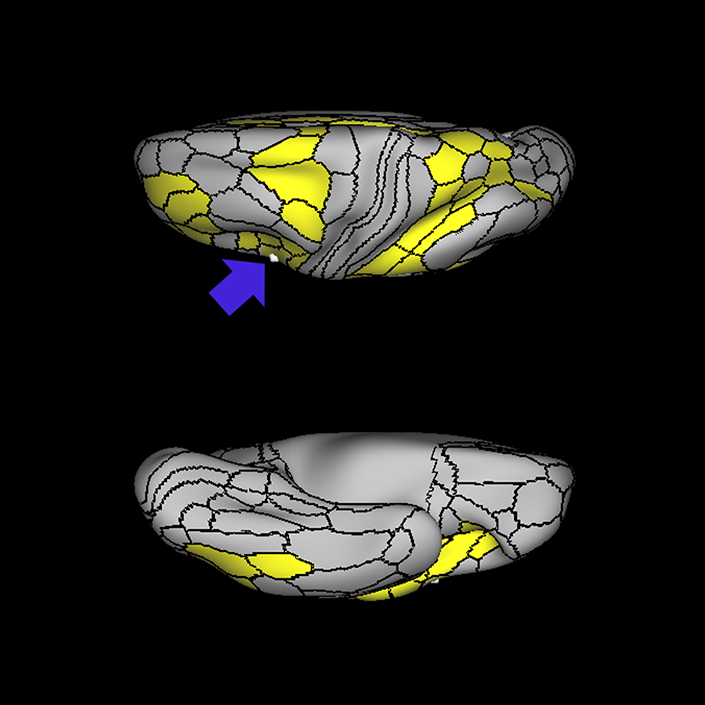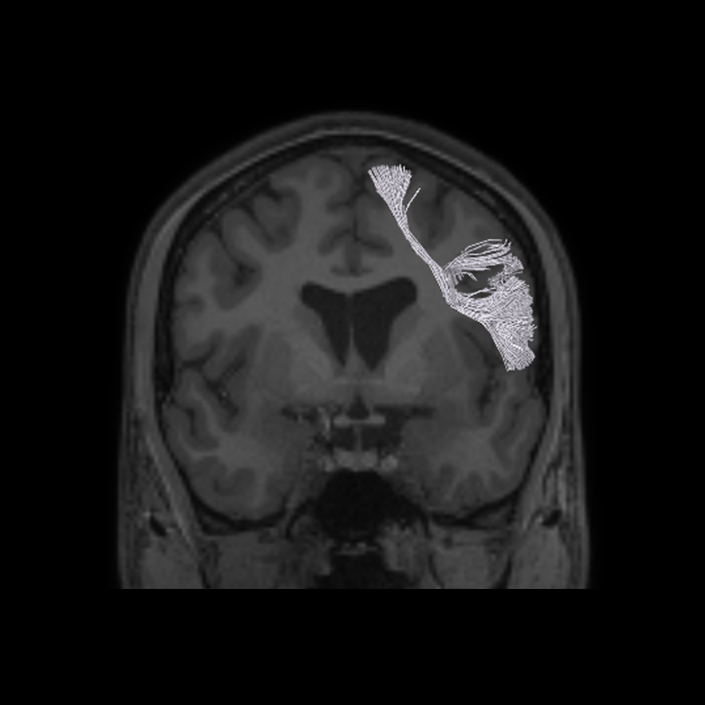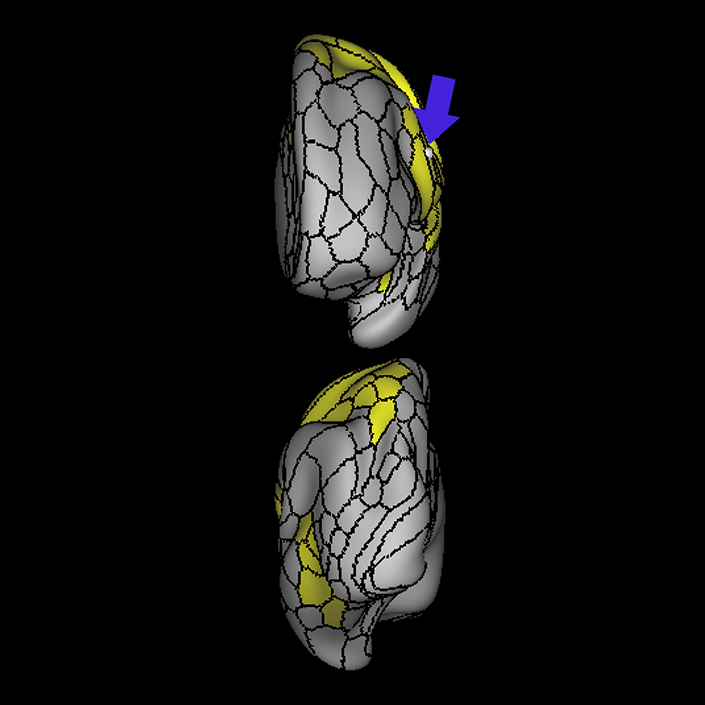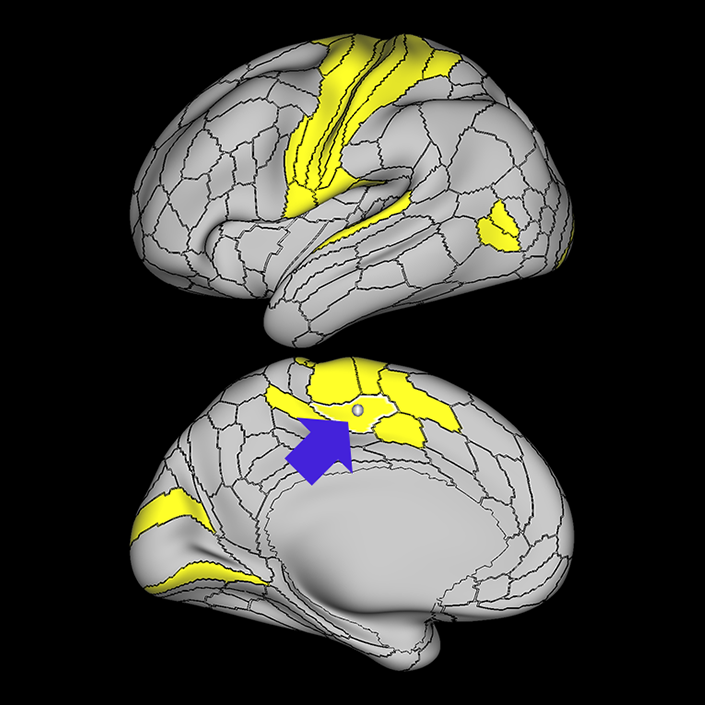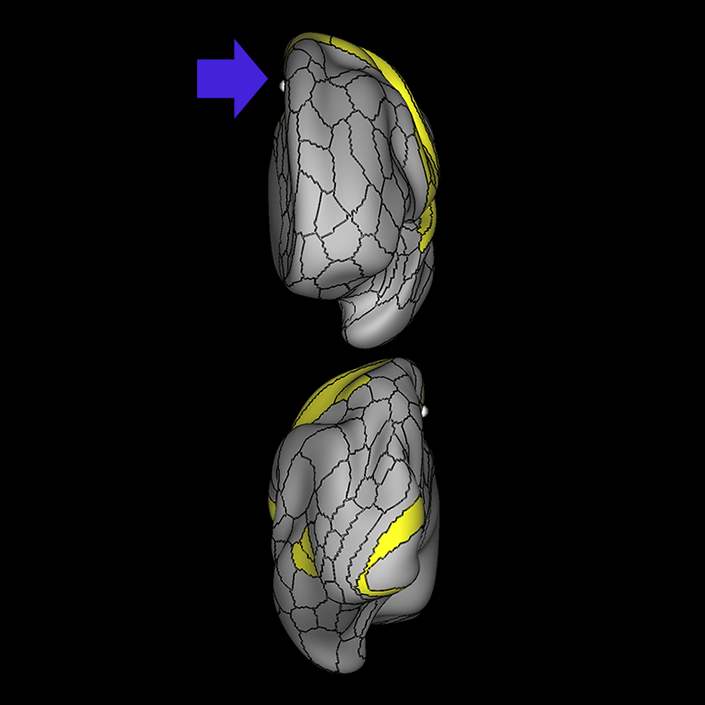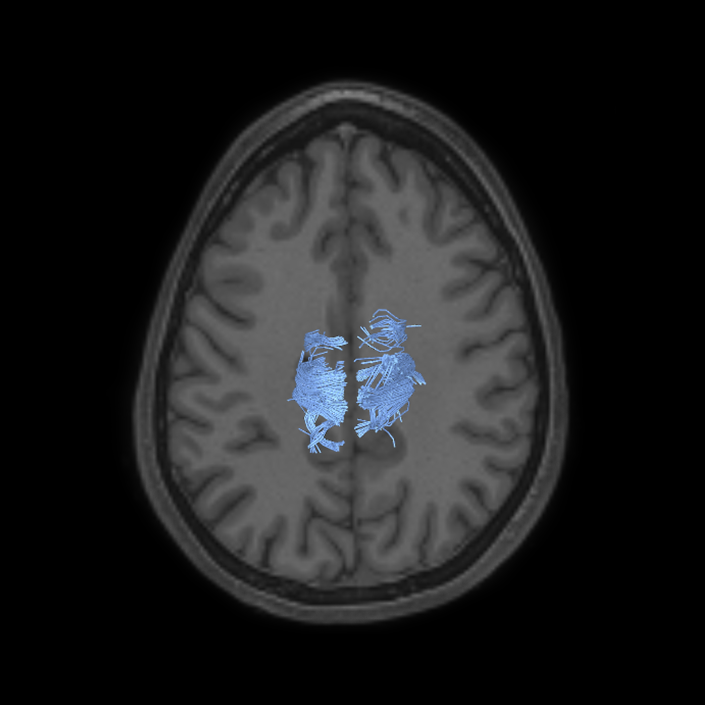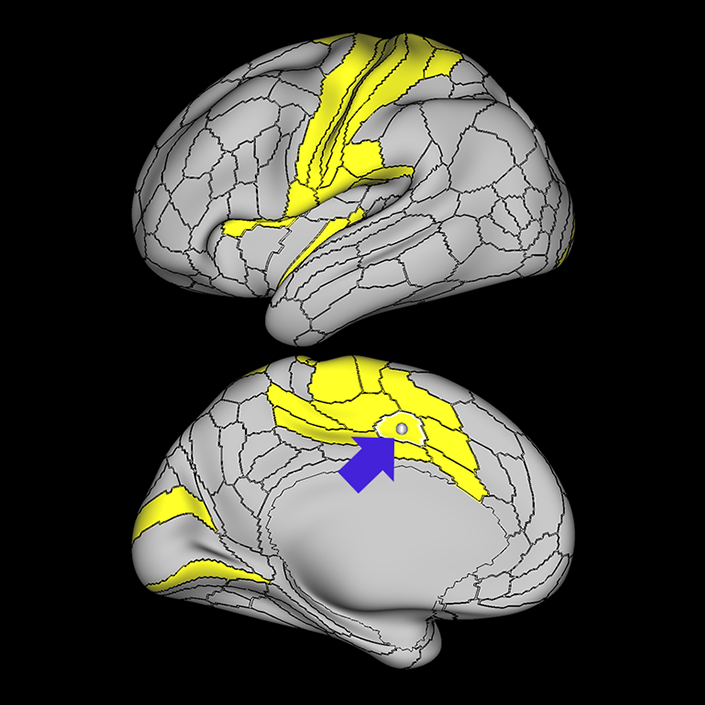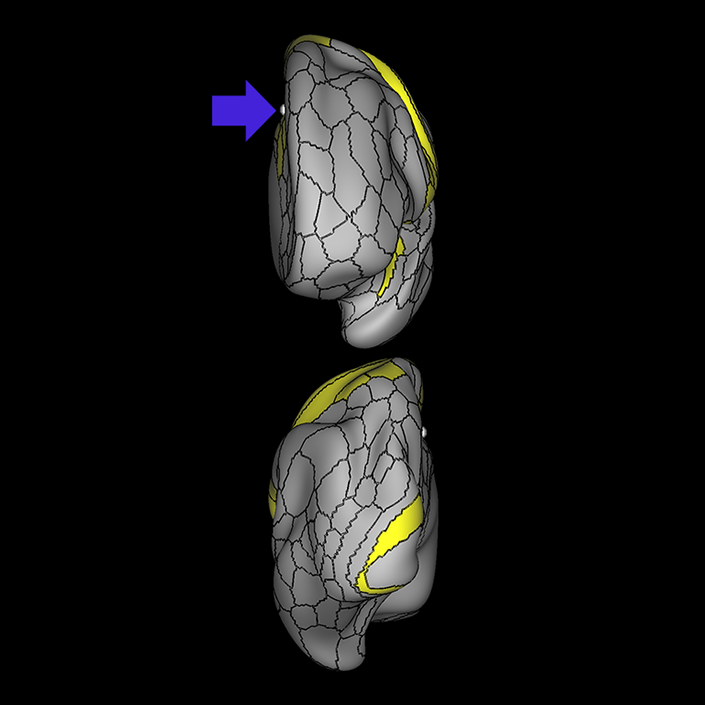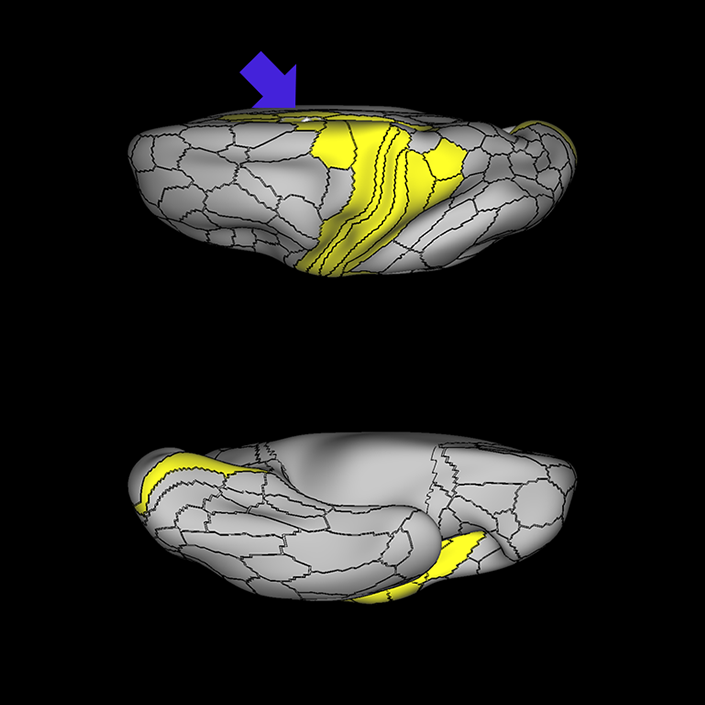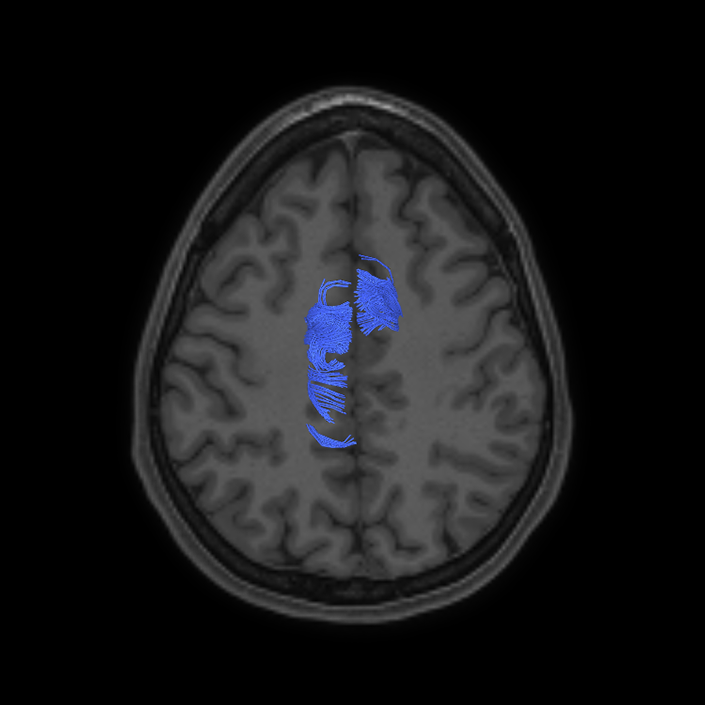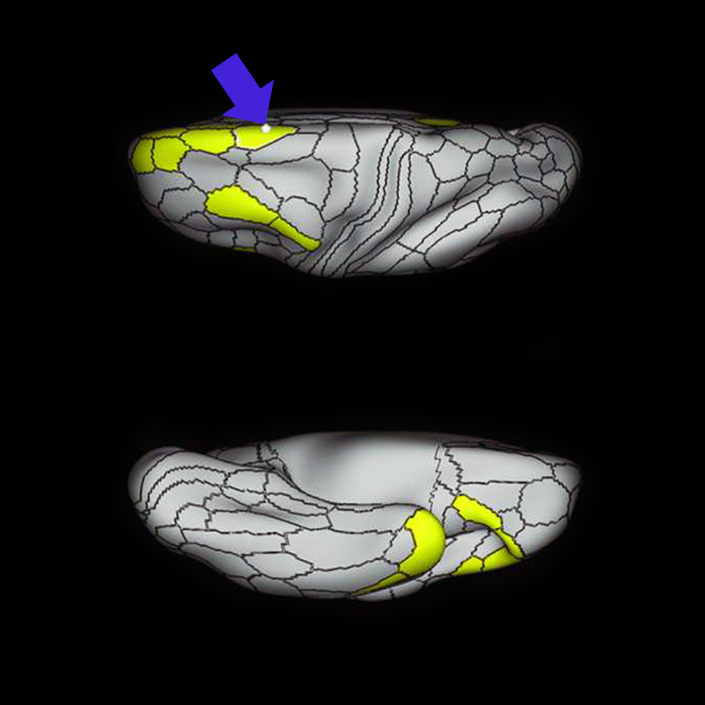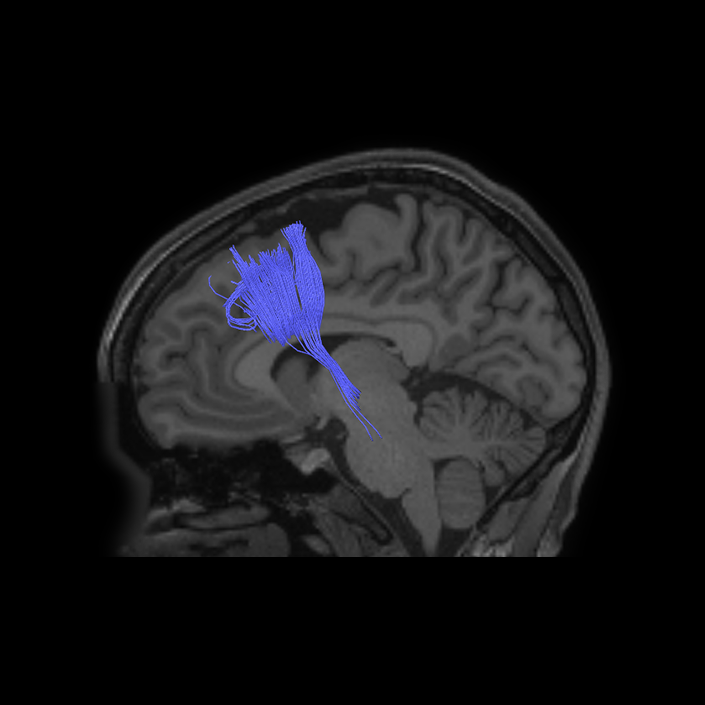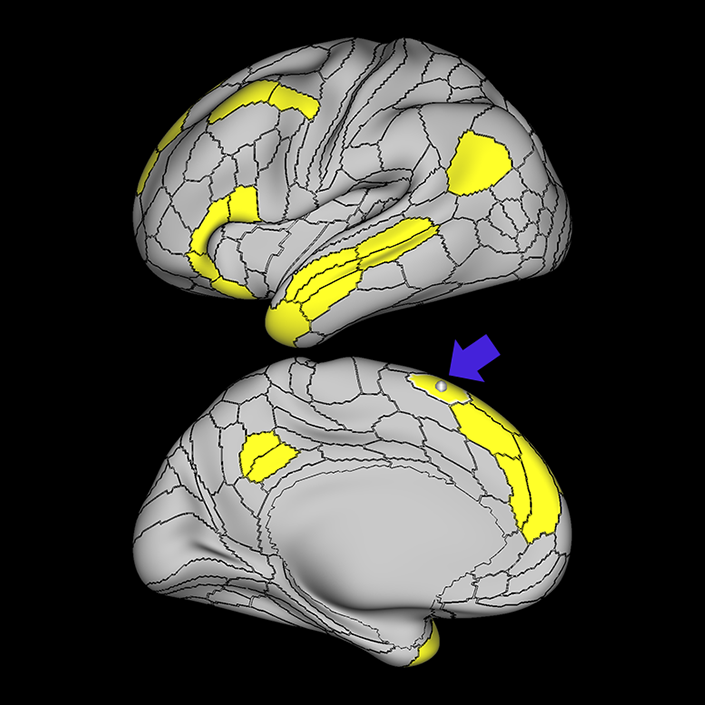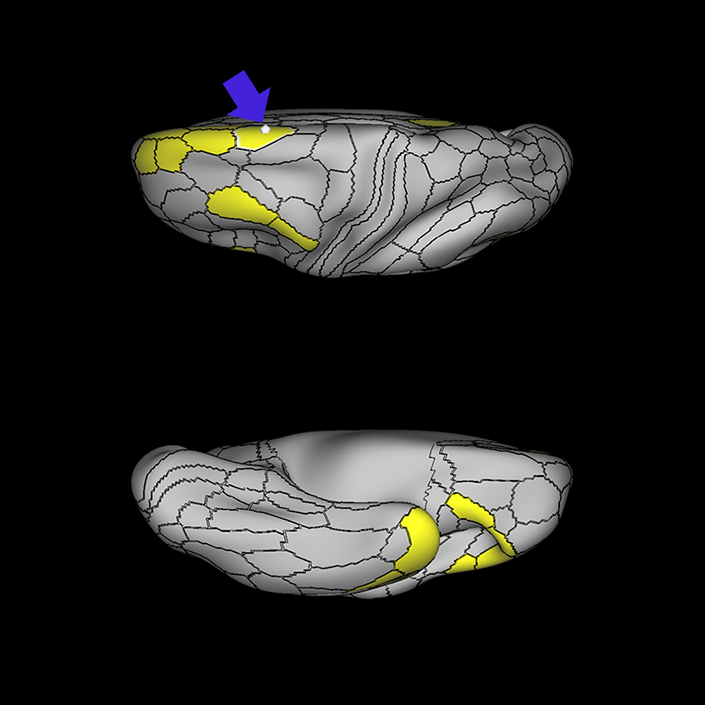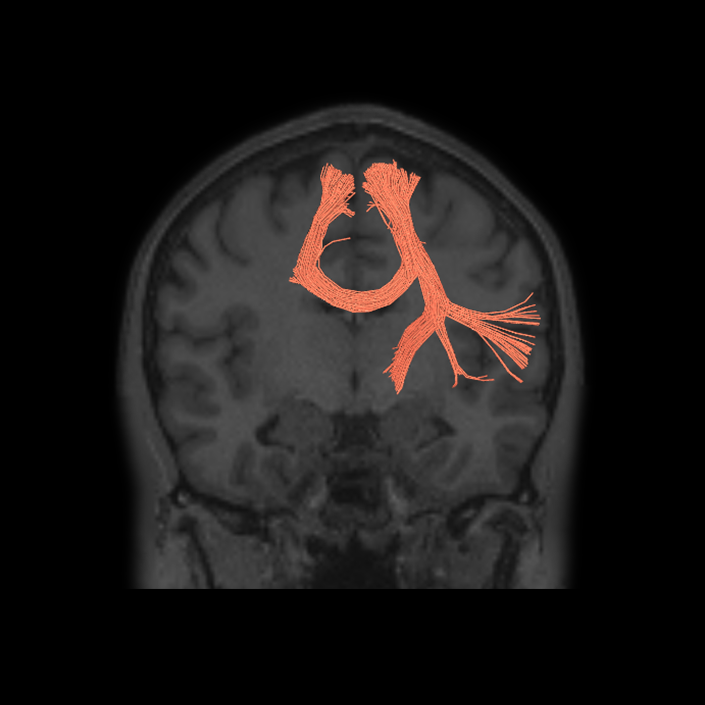ᐅ SummaryArea 1: part of primary sensory area. Along with area 3b, is involved in processing tactile stimuli. Specifically, area 1 represents the secondary point of activation following the reception of a tactile sensation activating area 3b. Area 1 also functions along with area 2 in receiving information related to bilateral tactile stimulation of the hands. ᐅ Where is it?Area 1 is found on the visible surface of the postcentral gyrus. It forms the largest bulk of the postcentral operculum. It continues up to the midline, but does not fold onto the medial face. ᐅ What are its borders?Area 1 borders area 3b along its anterior convexity border, and area 2 along its posterior border. Its inferior end borders OP4 and PFop. Its superior end is surrounded by areas 3b and 2. ᐅ What are its functional connections?Area 1 demonstrates functional connectivity to areas 2, 3a in the sensory strip, area 4 in the motor strip, areas SCEF, 6mp, 6d, and 6v in the premotor regions, areas 24dd, 24dv, 5m, and 5L in the middle cingulate regions, areas 43, OP1, OP2-3, OP4, IG, PFcm, and FOP2 in the superior insula opercular regions, areas A4, A5, RI, 52, MBelt, LBelt, PBelt, TA2, and STV in the lower opercula and Heschl's gyrus regions, areas LIPv, VIP, IPS1, 7AL and 7PC, in the parietal lobe, areas V2, V3, and V4 in the medial occipital lobe, areas V6, V6a, and V7 in the dorsal visual stream areas, area FFC of the ventral visual stream, and areas PH, TPOJ1, FST, V4t, MST, MT, and LO3 of the lateral occipital lobe. ᐅ What are its white matter connections?Area 1 is structurally connected to the pyramidal tracts, thalamocortical projections, and the parietal lobe. Connections to pyramidal tracts descend through the posterior limb of the internal capsule and cerebral peduncle to the brainstem. Thalamocortical tracts run medial to pyramidal projections to enter the thalamus. Parietal projections are portions of the SLF and connect to PFm. Local short association fibers are connected with 1, 2, 3a, 3b, 4 and 6. White matter tracts of area 1 in the right hemisphere have less consistent projections to surrounding parcellations. ᐅ What is known about its function?Area 1, along with area 3b, is involved in processing tactile stimuli. Specifically, area 1 represents the secondary point of activation following the reception of a tactile sensation activating area 3b. Area 1 also functions along with area 2 in receiving information related to bilateral tactile stimulation of the hands. |
|
A: lateral-medial
B: anterior-posterior
C: superior-inferior
DTI image |
Connectome Guide
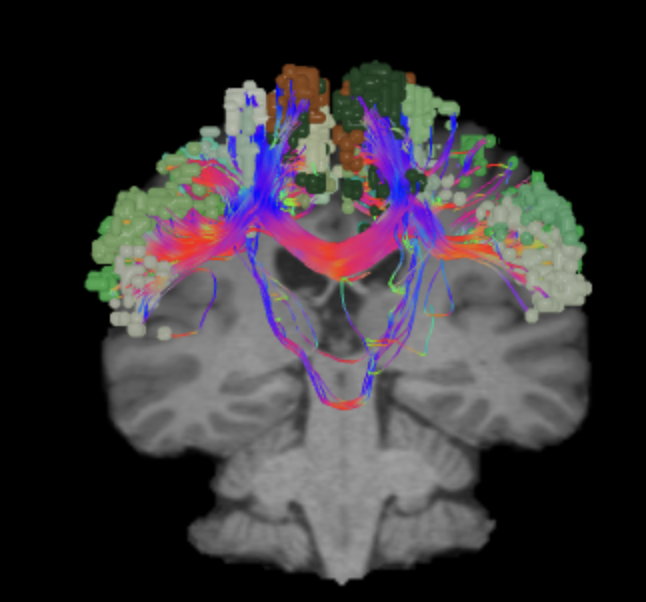
Sensorimotor Network
Why we think this network is worth considering in decision-making:
The importance of preserving motor and sensory function whenever possible in brain surgery, has never been in debate in neurosurgery. The role of motor planning regions and the ill effects of damage to these areas has been well understood since at least the 1980’s.
Evidence that this network is responsible for useful function in humans:
The precentral gyrus contained architecture has been known to be involved in motor function has been known since electrical stimulation experiments in dogs in the last 19th century. Subsequent, more detailed work by Penfield and Boldrey showed sensorimotor neural representation in the human brain as early as 1937 using cortical stimulation (Penfield & Boldrey, 1937). Later on, these findings were improved and extended using intracortical recordings for measuring somatosensory evoked potentials (Woolsey et al., 1979). Since then, neurosurgeons use SEPs routinely during their procedures to identify somatosensory areas to guide their surgical procedures.
Consequences of damage to this network:
The use of MRI based neuroimaging techniques to help preserve the structural integrity of this system is also well documented, and leads support to our claim that it is generally best whenever possible to not unnecessarily destroy human brain networks during surgery. For example, Zhang et al., 2009 demonstrated that spatial localization of sensorimotor cortex using “gold standard” intraoperative cortical simulation match with the resting state correlation mapping in patients with brain tumors (Zhang et al., 2009). A similar spatial overlap reported in epilepsy and tumor patients using electrical cortical stimulation (Mitchell et al., 2013). In the latter study, the investigators identified seven functional networks namely, DAN, VAN, SMN, VIS, FPC-central executive, LAN and the DMN, in the tumor patients and epilepsy patients and identified connected networks within the tumor as well as distant to the tumor. The consistency between stimulation mapping and the historically defined “eloquent” areas identified using network analysis supports the functional relevancy of the other networks identified in the same study. Importance of sensorimotor network is demonstrated in several disease processes such as Parkinson’s Disease (Herz et al., 2016; Zhao et al., 2018).
ᐅ SummaryArea 2: part of primary sensory area. Known to be involved in the processing of deep tissue sensations. Additionally, area 2 is activated in bilateral tactile stimulation of the hands. ᐅ Where is it?Area 2 is makes up most of the anterior bank of the post-central sulcus. It neither folds onto the midline nor reaches the Sylvian fissure. ᐅ What are its borders?Area 2 borders area 1 as its main anterior border. It makes a small anterior contact with area 3b superiorly. Inferiorly, it has a small border with PFop. Its superior border is mainly made up of area 5l. It borders area 7AL posterosuperiorly. Its long posterior border contacts (from superior to inferior): area 7PC, AIP, and PFt. ᐅ What are its functional connections?Area 2 demonstrates functional connectivity to areas 1, 3a, and 3b in the sensory strip, area 4 in the motor strip, areas SCEF, FEF, 6a, 6mp, 6d, and 6v in the premotor regions, areas 24dd, 24dv p32prime, 5mv, 5m, and 5L in the middle cingulate regions, areas 43, OP1, OP2-3, OP4, IG, PFcm, FOP1, and FOP2 in the superior insula opercular regions, areas PoI1, PoI2, A4, A5, RI, 52, A1, MBelt, LBelt, PBelt, TA2, and STV in the lower opercula and Heschl's gyrus regions, areas AIP, VIP, LIPv, PFop, PFt, IPS1, 7AL, and 7PC, in the parietal lobe, areas V2 and V3 in the medial occipital lobe, areas V6 in the dorsal visual stream areas, area FFC of the ventral visual stream, and areas PH TPOJ1, TPOJ2, FST, V4t, MST, MT, and LO3 of the lateral occipital lobe. ᐅ What are its white matter connections?Area 2 is structurally connected to the pyramidal tracts, thalamocortical projections, contralateral hemisphere and the parietal lobe. Connections to pyramidal tracts descend through the posterior limb of the internal capsule and cerebral peduncle to the brainstem. Thalamocortical tracts run medial to pyramidal projections to enter the thalamus. Contralateral connections course through the body of the corpus callosum to parcellation 7am. Parietal projections are portions of the SLF and connect to PFm, IP1 and IP2. Local short association fibers are connected with 6r, 7Pc, AIP, 1, 3a, 3b and 4. ᐅ What is known about its function?Area 2 is known to be involved in the processing of deep tissue sensations. Additionally, area 2 is activated in bilateral tactile stimulation of the hands. |
|
A: lateral-medial
B: anterior-posterior
C: superior-inferior
DTI image |
ᐅ SummaryArea 3a: Part of primary sensory area. along with area 2, is known to receive sensory information from deep body tissues. This area is also involved in the burning, chronic pain sensations that originate from deep somatic tissue. This suggests area 3a has relevance in many of the chronic pain ailments observed in the clinical setting. Area 3a is also involved in proprioception. ᐅ Where is it?Area 3a is found in the depth of the central sulcus. It follows this sulcus up to the midline but does not fold onto the medial face of the hemisphere. ᐅ What are its borders?Area 3a borders area 2 along its long anterior border and area 3b along its posterior border. Inferiorly, it borders area 23 and superiorly it borders area 5m. It has a small area of posterior contact with area 2 near the Sylvian fissure. ᐅ What are its functional connections?Area 3a demonstrates functional connectivity areas 1, 2, 4, 3b in the motor and sensory strips, areas SCEF, 55b, 6d, 6v, and 6mp in the premotor regions, areas 24dd, 24dv, 5m, and 5L in the middle cingulate regions, areas 43, OP1, OP2-3, OP4, IG, and FOP2 in the superior insula opercular regions, areas PoI2, 52, A4, A5, RI, A1, MBelt, PBelt, LBelt, TA2, and STV in the lower opercula and Heschl's gyrus regions, areas PFcm, 7AL, and 7PC, in the parietal lobe, areas V2, V3, and V4 in the medial occipital lobe, areas V6, V6a, V3a, and V7 in the dorsal visual stream areas, area FFC of the ventral visual stream, and areas PH, TPOJ1, FST, V4t, MST, MT, and LO3 of the lateral occipital lobe. ᐅ What are its white matter connections?Area 3a is structurally connected to the pyramidal tracts, thalamocortical projections, contralateral hemisphere and the parietal lobe. Connections to pyramidal tracts descend through the posterior limb of the internal capsule and cerebral peduncle to the brainstem. Thalamocortical tracts run medial to pyramidal projections to enter the thalamus. Contralateral connections course through the body of the corpus callosum to parcellations 3b and 4. Parietal projections are portions of the SLF and connect to PFm. Local short association fibers are connected with 4, 3b, 2, 1, and 6v. ᐅ What is known about its function?Area 3a, along with area 2, is known to receive sensory information from deep body tissues. This area is also involved in the burning, chronic pain sensations that originate from deep somatic tissue. This suggests area 3a has relevance in many of the chronic pain ailments observed in the clinical setting. Area 3a is also involved in proprioception. |
|
A: lateral-medial
B: anterior-posterior
C: superior-inferior
DTI image |
ᐅ SummaryArea 3b: Part of primary sensory area. involved in the sensation of tactile stimuli. Specifically, this area represents the initial regions of activation in tactile stimulation, followed by the activation of area 1. Area 3b also functions in the localization of sensation on the skin and distinguishing the features of that sensation. For example, activation of area 3b offers finger-specific information with respect to a tactile stimulus as opposed to areas 1 and 2 which cover a larger, more generalized receptive field. Additionally, area 3b receives exclusive activation in the reception of nociceptive stimuli. ᐅ Where is it?Area 3b is makes up the entire anterior bank of the postcentral gyrus. It does not reach the Sylvian fissure or fold onto the medial hemispheric face. ᐅ What are its borders?Area 3b borders area 3a along its anterior convexity border, and area 2 along its long posterior convexity border. Its inferior end ends superior to the Sylvian fissure and areas 3a and 2 contact each other inferior to this, forming area 3b's inferior border. Superomedially, it contacts areas 5m and 5l. It also makes a small border with area 2 posterosuperiorly. ᐅ What are its functional connections?Area 3b demonstrates functional connectivity to areas 1, 2, 3a in the sensory strip, area 4 in the motor strip, areas SCEF, 6d, and 6v in the premotor regions, areas 24dd, 24dv, 5m, and 5L in the middle cingulate regions, areas 43, OP1, OP2-3, OP4, IG, PFcm, and FOP2 in the superior insula opercular regions, areas A4, A5, RI, 52, A1, MBelt, LBelt, PBelt, TA2, and STV in the lower opercula and Heschl's gyrus regions, areas 7AL and 7PC, in the parietal lobe, areas V2, V3, and V4 in the medial occipital lobe, areas V6, V6a, V3a, and V7 in the dorsal visual stream areas, area FFC of the ventral visual stream, and areas TPOJ1, FST, V4t, MST, MT, and LO3 of the lateral occipital lobe. ᐅ What are its white matter connections?Area 3b is structurally connected to the pyramidal tracts, thalamocortical projections, contralateral hemisphere and the parietal lobe. Connections to pyramidal tracts descend through the posterior limb of the internal capsule and cerebral peduncle to the brainstem. Thalamocortical tracts run medial to pyramidal projections to enter the thalamus. Contralateral connections course through the body of the corpus callosum to parcellations 3a, 3b and 4. Parietal projections are portions of the SLF and connect with IP1 and IP2. Local short association fibers are connected with 1, 2, 3a and 4. ᐅ What is known about its function?Area 3b is involved in the sensation of tactile stimuli. Specifically, this area represents the initial region of activation in tactile stimulation, followed by the activation of area 1. Area 3b also functions in the localization of sensation on the skin and distinguishing the features of that sensation. For example, activation of area 3b offers finger-specific information with respect to a tactile stimulus as opposed to areas 1 and 2 which cover a larger, more generalized receptive field. Additionally, area 3b receives exclusive activation in the reception of nociceptive stimuli. |
|
A: lateral-medial
B: anterior-posterior
C: superior-inferior
DTI image |
ᐅ SummaryArea 4: part of primary motor cortex. Known to produce fine motor movements of the distal forearm and fingers. Additionally, it functions in giving a muscle its tone and producing forceful muscle contractions. It is also thought to play a role in visual learning of motor-based skills in the early stages of life. ᐅ Where is it?Area 4 is found in the precentral gyrus. It is predominantly located on the posterior half of the gyrus, making up the anterior bank of the central sulcus. It widens medially to fill a larger proportion of the paracentral lobule, which is the leg motor region. The somatotopic organization of this area is well known, however it is worth noting that there is an area dedicated to the eye which is adjacent to the frontal eye fields. ᐅ What are its borders?Area 4 borders area 3a along its posterior convexity border. Its inferior end contains area 43. At its superior end, on the medial surface (i.e. the paracentral lobule), it borders area 5m posteriorly, area 44dd inferiorly, and area 6mp anteriorly. Its long anterior border contacts several areas, including (from superior to inferior): area 6d, FEF, area 55b, PEF, and area 6v, most of which contact it on the anterior half of the precentral gyrus. ᐅ What are its functional connections?Area 4 demonstrates functional connectivity to areas 1, 2, 3a, 3b in the sensory strip, areas SCEF, 55b, 6d, 6v, and 6mp in the premotor regions, areas 24dd, 24dv, 5m, and 5L in the middle cingulate regions, areas 43, OP1, OP2-3, OP4, IG, and FOP2 in the superior insula opercular regions, areas A4, A5, RI, PBelt, LBelt, TA2, and STV in the lower opercula and Heschl's gyrus regions, areas VIP, IPS1, LIPv and 7PC, in the parietal lobe, areas V2, V3, and V4 in the medial occipital lobe, areas V6, V6a, V3a, and V7 in the dorsal visual stream areas, area FFC of the ventral visual stream, and areas PH, TPOJ1, FST, V4t, MT, and LO3 of the lateral occipital lobe. ᐅ What are its white matter connections?Area 4 is structurally connected to pyramidal tracts, the contralateral hemisphere and the parietal lobule. Connections to pyramidal tracts descend through the posterior limb of the internal capsule and cerebral peduncle to the brainstem. Contralateral connections course through the body of the corpus callosum to parcellations 4, 6ma and 6mp. Parietal projections are portions of the SLF and connect to PFm. Local short association fibers are connected with 3a, 3b, 2, 1, and 6v. ᐅ What is known about its function?Area 4 is known to produce fine motor movements of the distal forearm and fingers. Additionally, it functions in giving a muscle its tone and producing forceful muscle contractions. It is also thought to play a role in visual learning of motor-based skills in the early stages of life. |
|
A: lateral-medial
B: anterior-posterior
C: superior-inferior
DTI image |
ᐅ SummaryArea 6a (6 anterior): part of the premotor areas. While the precise function of this area is unknown, the functions of the premotor cortex are well characterized in the literature. 6a shows greater activation when solving math problems, in social interaction settings, and when performing object feature comparison tasks. ᐅ Where is it?Area 6a (6 anterior) makes up the posterior superior most bank of the superior frontal sulcus and the adjacent portions of the superior frontal gyrus, principally forming this bank just as the sulcus forms the right angle with the precentral sulcus. ᐅ What are its borders?Area 6a borders areas 6d and 6mp posteriorly, and area 6ma medially. Its anterior border is made by s6-8, area 8AD, and i6-8. FEF is its inferior neighbor. ᐅ What are its functional connections?Area 6a demonstrates functional connectivity to area 2 in the sensory strip, areas SCEF, PEF, FEF, 6ma, 6mp, 6d, and 6v in the premotor regions, areas a24prime, p32prime, 5mv, and 23c in the middle cingulate regions, areas IFSa, IFJa, i6-8, 46, p9-46v and 9-46d in the lateral frontal lobe areas OP4, PFcm, FOP4, and FOP2 in the superior insula opercular regions, areas PoI1 and PoI2 in the lower opercula and Heschl's gyrus regions, areas TE2p, PHA3 and PHT in the temporal lobe, areas AIP, MIP, VIP, LIPd, LIPv, PFop, PF, PFt, PGp IP2, IP1, IP0, IPS1, 7AL,7PL, and 7PC, in the lateral parietal lobe, areas 7pm, 7am, DVT, and PCV in the medial parietal lobe, area V2 in the medial occipital lobe, and areas PH, TPOJ2, TPOJ3, and FST of the lateral occipital lobe. ᐅ What are its white matter connections?Area 6a is structurally connected to the pyramidal tracts and the parietal lobe. Connections to pyramidal tracts descend through the posterior limb of the internal capsule and cerebral peduncle to the brainstem. Parietal projections are portions of the SLF and connect with 3a, 3b, 7PC and 7AL. Local short association fibers connect with FEF, i6- 8, 55b, 8Av, 46 and 6r. ᐅ What is known about its function?Areas 6a and 6d are newly described subdivisions of the premotor cortex. While the precise function of these areas is unknown, the functions of the premotor cortex are well characterized in the literature. First, the premotor cortex is functionally divided into ventral and dorsal aspects. The dorsal premotor cortex is involved in associating informational cues with a particular body movement. These cues could be learned and arbitrary in nature or they can be based on other forms of somatosensation, such as visual or auditory sensation. The ventral premotor area is involved in hand movement manipulation of objects, e.g. when grasping or lifting. The ventral premotor area is also involved in more complex cortical functions such as when individuals learn actions or movements while observing others performing a task. Overall, the premotor cortex has significant function in the preparation of voluntary movements. Regarding area 6a more specifically, this region was distinguished from adjacent areas of the cortex based on differences in myelin thickness and functional activity.9 Compared to area s6-8, area 6a shows greater activation when solving math problems, in social interaction settings, and when performing object feature comparison tasks. Compared to area i6-8, area 6a shows greater activation in social interaction settings and relative deactivation in emotion identification and object feature comparison. Compared to area FEF, area 6a shows less activation in both gambling and object feature comparison. |
|
A: lateral-medial
B: anterior-posterior
C: superior-inferior
DTI image |
ᐅ SummaryArea 6d (6 dorsal): part of the premotor areas. Shows less activation compared to area FEF during gambling tasks, in social interaction settings, and during object feature comparison. Compared to area 6a, area 6d shows less activation in solving math problems and in social interaction settings. ᐅ Where is it?Area 6d (6 dorsal) is located on the anterosuperior portion of the precentral gyrus, just inferior to its junction with the SFG. It makes up the posterior bank of the adjacent precentral sulcus. ᐅ What are its borders?Area 6d borders area 6mp superiorly and FEF inferiorly. Area 4 is its posterior border and area 6a forms its anterior border across the precentral sulcus. ᐅ What are its functional connections?Area 6d demonstrates functional connectivity to areas 1, 2, 3a, and 3b in the sensory strip, area 4 in the motor strip, areas 6a, 6mp and 6v in the premotor regions, areas 5L and 24dd in the middle cingulate regions, areas FOP2, OP4, OP1, A4 and PBelt in the insula opercula regions, areas 7PC, 7AL, and PFt in the parietal lobe, and area FST in the lateral occipital lobe. ᐅ What are its white matter connections?Area 6d is structurally connected to the pyramidal tracts and contralateral hemisphere. Connections to pyramidal tracts descend through the posterior limb of the internal capsule and cerebral peduncle to the brainstem. Contralateral connections course through the body of the corpus callosum to end at 6mp, FEF and 55b. Local short association fibers connect with 4, 3a, 3b, 6a, FEF, i6-8, 8Av, 3a, 3b, 6ma and 6d. ᐅ What is known about its function?Area 6d was distinguished from adjacent areas of the cortex based on differences in myelin thickness and functional connectivity. Area 6d shows less activation compared to area FEF during gambling tasks, in social interaction settings, and during object feature comparison. Compared to area 6a, area 6d shows less activation in solving math problems and in social interaction settings. |
|
A: lateral-medial
B: anterior-posterior
C: superior-inferior
DTI image |
ᐅ SummaryArea 6ma (6 medial anterior): part of the supplementary motor regions areas. shows more activation compared to areas 6mp, SFL, or s6-8 when individuals are given a visual instruction cue. Area 6ma also showed greater deactivation compared to area SFL when individuals are told a story. Area 6ma also showed less functional activity compared to area s6-8 when individuals had to match objects based on given verbal categories. ᐅ Where is it?Area 6ma (6 medial anterior) makes up the lateral posterior portion of the superior frontal gyrus. It mainly straddles the interhemispheric angle ᐅ What are its borders?Area 6ma borders area 6mp posteriorly, SCEF and SFL inferiorly/medially and area 6a laterally. Its anterior neighbor is s6-8. ᐅ What are its functional connections?Area 6ma demonstrates functional connectivity to, areas SCEF, PEF, FEF, 6r, 6a, 6v, and 6mp in the premotor regions, areas a24prime, p24 prime, p24prime, a32prime, p32prime, 23c, and 5mv in the middle and posterior cingulate regions, areas IFSa, 9-46d a9-46v, p9-46v, and 46 in the dorsolateral frontal lobe, areas PoI1, PoI2, AVI, MI, 43, PFcm, FOP1, FOP3, FOP4, and FOP5 in the insula opercular regions, areas IP2, IP0, AIP, MIP, LIPd, PGp, PFop, PF, PFt, 7AL, 7PL, and 7PC, in the lateral parietal lobe, and areas 7am, 7pm, PCV and DVT in the medial parietal lobe. ᐅ What are its white matter connections?Area 6ma is structurally connected to the pyramidal tracts, the frontal aslant tract (FAT) and contralateral hemisphere. Connections to pyramidal tracts descend through the posterior limb of the internal capsule and cerebral peduncle to the brainstem. The FAT connects 6ma with the inferior frontal gyrus terminating at parcellations 44, FOP4 and AAIC. Contralateral connections course through the body of the corpus callosum to 6ma. Local short association fibers connect 6mp, SFL, 6a, i6-8 and s6-8. ᐅ What is known about its function?Area 6ma was subdivided from adjacent parcellations due to differences in myelin thickness and functional activity. Specifically, 6ma shows more activation compared to areas 6mp, SFL, or s6-8 when individuals are given a visual instruction cue. Area 6ma also showed greater deactivation compared to area SFL when individuals are told a story. Area 6ma also showed less functional activity compared to area s6-8 when individuals had to match objects based on given verbal categories. |
|
A: lateral-medial
B: anterior-posterior
C: superior-inferior
DTI image |
ᐅ SummaryArea 6mp (6 medial posterior): part of the supplementary motor regions areas. shows less activation compared to 6ma when an individual was given a visual instruction cue and when moving their feet. Compared to 6d, 6mp shows greater deactivation when listening to a story or solving a math problem. Lastly, compared to area 6a, area 6mp shows less activation in social interaction settings. ᐅ Where is it?Area 6mp (6 medial posterior) makes up the area where the SFG joins with the precentral gyrus. It makes up the medial bank of the SFG at this junction, as well as spilling onto the superior surface of the posterior most SFG and the anterosuperior portion of the precentral gyrus. It also makes up the most posterior superior portion of the superior bank of the superior frontal sulcus. ᐅ What are its borders?Area 6mp borders area 4 posteriorly, area 6d laterally, area 6a anterolaterally, areas 6ma and SCEF anteriorly, and area 24dd inferiorly on the medial surface. ᐅ What are its functional connections?Area 6mp demonstrates functional connectivity to areas 1, 2, 3a, and 3b in the sensory strip, area 4 in the motor strip, areas SCEF, 6a, 6ma, and 6d in the premotor regions, areas 24dd, 24dv, p32prime, 5mv, and 5L in the middle cingulate regions, areas 43, OP1, OP4, PFcm, FOP1, and FOP2 in the superior insula opercular regions, areas A4, RI, and PBelt in the lower opercula and Heschl’s gyrus regions, areas PFop, PFt, IPS1, 7AL, and 7PC, in the parietal lobe, areas, and area FST in the lateral occipital lobe. ᐅ What are its white matter connections?Area 6mp is structurally connected to the pyramidal tracts and contralateral hemisphere. Connections to pyramidal tracts descend through the posterior limb of the internal capsule and cerebral peduncle to the brainstem. Contralateral connections course through the body of the corpus callosum to 6ma, 6mp and FEF. Local short association fibers connect with 24dd, 6a and 6d. ᐅ What is known about its function?Area 6mp was subdivided from adjacent parcellations due to differences in myelin thickness and functional activity. Specifically, area 6mp shows less activation compared to 6ma when an individual was given a visual instruction cue and when moving their feet. Compared to 6d, 6mp shows greater deactivation when listening to a story or solving a math problem. Lastly, compared to area 6a, area 6mp shows less activation in social interaction settings. |
|
A: lateral-medial
B: anterior-posterior
C: superior-inferior
DTI image |
ᐅ SummaryArea 6r (6 rostral): part of the premotor areas. Has not been extensively studied. The literature indicates that this area is functionally related to Broca's area in humans, which is a well-known cortical area essential to language processing. ᐅ Where is it?Area 6r (6 rostral) is the inferior portion of the precentral sulcus, including its floor and both banks. The latter point implies that some of area 6r lies on both the anterior inferior portion of the precentral gyrus and the posterior portion of the pars opercularis of the inferior frontal gyrus. The inferior extent of the precentral sulcus forms a shovel shaped cup near the opercular edge and this cup is area 6r. ᐅ What are its borders?Area 6r borders area 44 anteriorly and area 43 posteriorly. Area 6v forms a posterosuperior border with it. PEF is its main superior neighbor, while IFJp and IFJa form an anterior superior border. FOP1 and FOP4 form its inferior border on its undersurface opercular surface. ᐅ What are its functional connections?Area 6r demonstrates functional connectivity to areas SCEF, FEF PEF, 6ma, 6a and 6v in the premotor regions, areas 23c, 5mv, a24prime, p24prime,and p32prime in the middle cingulate regions, areas 46, p9-46v, 9-46d, IFSa, IFJa, IFJp, and p47r in the lateral frontal lobe, areas 43, OP4, PFcm, FOP2 FOP3, FOP4, and FOP5 in the superior insula opercular regions, areas AVI, MI, PoI1, and PoI2 in the lower opercula and Heschl's gyrus regions, areas TE2p and PHT in the temporal lobe, areas AIP, MIP, LIPd, LIPv, PFop, PF, PFt, IP0, 7PL, 7AL, and 7PC, in the lateral parietal lobe, and areas PH, and FST of the lateral occipital lobe. ᐅ What are its white matter connections?Area 6r is structurally connected to the superior longitudinal fasciculus and frontal aslant tract. FAT connects 6r with the superior frontal gyrus at parcellation SFL. Connections with the superior longitudinal fasciculus connect 6r to posterior temporal parcellations TE1a and TE2a. Local short association fibers connect with 6v, 44, IFJa, IFJp, 8C and IFSa. ᐅ What is known about its function?Area 6r has not been extensively studied. The literature indicates that this area is functionally related to Broca's area in humans, which is a well-known cortical area essential to language processing. |
|
A: lateral-medial
B: anterior-posterior
C: superior-inferior
DTI image |
ᐅ SummaryArea 6v (6 ventral): part of the premotor areas. Comprises what is classically known as the premotor cortex. It has many different functions. The ventral premotor area is known to be active in the control of hand movements that occur while manipulating objects (eg grasping and lifting objects), and the dorsal premotor area is involved in performing specific motor tasks based on visual cues. ᐅ Where is it?Area 6v (6 ventral) makes up the antero-inferior one-third of the precentral gyrus. It only minimally forms the posterior bank of the precentral sulcus, which is primarily formed by area 6r. ᐅ What are its borders?Area 6v borders area 55b superiorly and area 43 inferiorly. Area 4 is its posterior border and areas 6r and PEF form its anterior border. ᐅ What are its functional connections?Area 6v is connected to areas 1, 2, 3a, 3b in the sensory strip, area 4 in the motor strip areas SCEF, FEF PEF, 6ma, 6mp, 6r, 6d, and 6v in the premotor regions, areas 24dd and p32prime in the middle cingulate regions, areas 43, OP4, OP2-3, OP1, PFcm, FOP1 FOP2, FOP3, and FOP4 in the superior insula opercular regions, areas A4, PBelt, RI, and PoI2 in the lower opercula and Heschl's gyrus regions, areas AIP, MIP, VIP, LIPv, PFop, PFt, 7AL, and 7PC, in the lateral parietal lobe, areas V3a, V3b, V6, V6a, and V7 of the dorsal visual stream, areas FFC of the ventral visual stream, and areas PH, TPOJ2, MST, and FST of the lateral occipital lobe. ᐅ What are its white matter connections?Area 6v is structurally connected to the contralateral hemisphere and the superior longitudinal fasciculus. Contralateral connections course through the body of the corpus callosum to FEF. Connections with the superior longitudinal fasciculus connect 6v to inferior parietal lobe parcellations PHT, FST, PH and PF. Local short association fibers connect with 4, 6r, PEF, 43, 3a and 3b. ᐅ What is known about its function?Area 6v comprises what is classically known as the premotor cortex. It has many different functions. The ventral premotor area is known to be active in the control of hand movements that occur while manipulating objects (e.g. grasping and lifting objects), and the dorsal premotor area is involved in performing specific motor tasks based on visual cues. |
|
A: lateral-medial
B: anterior-posterior
C: superior-inferior
DTI image |
ᐅ SummaryArea 24dd (24 dorsal-dorsal): part of anterior cingulate regions. Has been implicated in complex motor planning and regulation of muscles in the lower limb and lower trunk through coordination with the supplemental motor area and connections to the spinal cord. ᐅ Where is it?Area 24dd (24 dorsal-dorsal) is located in the anterior inferior paracentral lobule straddling into the upper bank of the cingulate sulcus. ᐅ What are its borders?Area 24dd has as its superior boundaries, from anterior to posterior, SCEF, area 6mp, area 4, and area 5m. It continues into the marginal ramus of the cingulate sulcus, bordering area 5mv posteriorly and inferiorly. Its inferior border includes area 24dv and area 23c. ᐅ What are its functional connections?Area 24dd demonstrates functional connectivity to areas 1, 2, 3a, and 3b in the sensory strip, area 4 in the motor strip, areas 6mp, 6v, and 6d, in the premotor regions, areas 5mv, SCEF, and 24dv in the middle cingulate regions, areas OP4, OP1, and 43 in the superior opercular areas, areas PBelt and A4 in the lower opercula and Heschl's gyrus regions, area 7PC in the parietal lobe, area V2 in the primary visual areas, and areas FST and MST in the lateral occipital lobe. ᐅ What are its white matter connections?Area 24dd is structurally connected to the contralateral hemisphere. Fibers from 24dd project through the body of the corpus callosum to end at 24dd, 4, 5mv, 23c, SCEF, 6mp and 24dv. Local short association bundles connect with 4, 5mv, 23c, SCEF and 6mp. ᐅ What is known about its function?Area 24dd has been implicated in complex motor planning and regulation of muscles in the lower limb and lower trunk through coordination with the supplemental motor area and connections to the spinal cord. |
|
A: lateral-medial
B: anterior-posterior
C: superior-inferior
DTI image |
ᐅ SummaryArea 24dv (24 dorsal-ventral): part of anterior cingulate regions. Has been implicated in complex motor planning and regulation of muscles in the upper limb and upper trunk muscles through coordination with the supplemental motor area and connections to the spinal cord. ᐅ Where is it?Area 24dv (24 dorsal-ventral) is located in the anterior inferior paracentral lobule and straddles into the upper bank of the cingulate sulcus. ᐅ What are its borders?Area 24dv has 24dd as its superior border, p32pr and a small portion of SCEF as its anterior border, p24pr as its inferior border, and 24dd as its posterior border. Note that this area causes the 24 areas and the 32 areas to be slightly out of sync in their anterior to posterior alignment. ᐅ What are its functional connections?Area 24dv demonstrates functional connectivity to areas 1, 2, 3a, and 3b in the sensory strip, area 4 in the motor strip, area 6mp in the premotor regions, areas 5mv, SCEF, a24prime, p24prime, p32prime, 23c, and 24dd in the middle cingulate regions, areas FOP1, FOP3, FOP4, PFcm, OP4, OP1, and 43 in the superior opercular areas, areas PoI1 and 52 in the lower opercula and Heschl's gyrus regions, areas 7AL, 7PC, and PFop in the parietal lobe, and area V2 in the primary visual areas. ᐅ What are its white matter connections?Area 24dv is structurally connected to the contralateral hemisphere, marginal branch of the cingulate sulcus and precuneus. Contralateral connections course through the body of the corpus callosum to 24dv, SCEF and p32pr. Fibers from 24dv project posterior to the marginal branch of the cingulate sulcus and precuneus areas to 23c and 31a. Local short association fibers connect with SCEF, p32pr and 24dv. ᐅ What is known about its function?Area 24dv has been implicated in complex motor planning and regulation of muscles in the upper limb and upper trunk muscles through coordination with the supplemental motor area and connections to the spinal cord. |
|
A: lateral-medial
B: anterior-posterior
C: superior-inferior
DTI image |
ᐅ SummaryArea SCEF (supplementary and cingulate eye field): part of medial superior frontal gyrus regions. Higher order oculomotor center implicated in appraising all possible oculomotor behaviors to direct primary oculomotor centers in goal- directed behavior. ᐅ Where is it?Area SCEF (supplementary and cingulate eye field) is located in the posterior medial SFG. ᐅ What are its borders?Area SCEF borders area 8BM anteriorly, areas 6ma and SFL superiorly, areas 6mp and 24dd posteriorly, and areas 24dv and p32pr inferiorly. ᐅ What are its functional connections?Area SCEF demonstrates functional connectivity to areas 1, 2, 3a, 3b in the sensory strip, area 4 in the motor strip, areas PEF, FEF, 55b, 6ma, 6mp, 6a, 6r, and 6v in the premotor regions, areas a24prime, p32prime, a32prime, 5mv, and 23c in the middle cingulate regions, areas IFJa, 46, and 9-46d in the lateral frontal lobe areas OP4, OP1, PFcm, 43, FOP1, FOP2, FOP3 FOP4, and FOP5 in the superior insula opercular regions, areas PSL, 52, A4, MI, PoI1 and PoI2 in the lower opercula and Heschl's gyrus regions, area PHT in the temporal lobe, areas AIP, MIP, VIP, LIPd, LIPv, PFop, PF, PFt, IP0, IPS1, 7AL, 7PL, and 7PC, in the lateral parietal lobe, areas 7am and DVT in the medial parietal lobe, area V1, V2, V3, V4 in the medial occipital lobe, areas V3a, V3b, V6, V6a, and V7 in the dorsal visual stream, area FFC of the ventral visual stream, and areas PH, TPOJ2, LO3, MST, and FST of the lateral occipital lobe. ᐅ What are its white matter connections?Area SCEF is structurally connected to the contralateral hemisphere and thalamus. Contralateral connections course through the body of the corpus callosum to end at SCEF, 8BL, SFL and 8BM. Thalamic projections travel through the ventral thalamus to the brainstem (Figure 32). Local short association bundles connect with SF, 8BM, SFL and 8BL. ᐅ What is known about its function?Area SCEF is a higher order oculomotor center implicated in appraising all possible oculomotor behaviors to direct primary oculomotor centers in goal-directed behavior. |
|
A: lateral-medial
B: anterior-posterior
C: superior-inferior
DTI image |
ᐅ SummaryArea SFL: part of the supplementary motor regions. Known to be hemispherically asymmetric. Specifically, the left hemisphere shows more activity when listening to stories and when a participant is matching objects based on a verbal cue. Compared to area 8BL, area SFL shows more activation when listening to a story, matching objects based on verbal cues and in social interaction settings. Compared to area s6-8, area SFL shows more activation in the left hemisphere when individuals listen to a story. In the right hemisphere, area SFL is activated insocial interaction settings and is deactivated during object feature comparison tasks. ᐅ Where is it?Area SFL (superior frontal language area) is located on the posterior medial SFG straddling over the interhemispheric cleft. ᐅ What are its borders?Area SFL borders SCEF inferiorly. Its anterior inferior neighbor is area 8BM and its anterior superior neighbor is area 8BL. Areas 6ma and s6-8 are its lateral neighbors. ᐅ What are its functional connections?Area SFL demonstrates functional connectivity to areas 8BL, 8AV, 9a, 9p, and 9m in dorsolateral frontal lobe, areas 8BM, d32, areas 44, 45, 47L, and 47s in the inferior frontal lobe, area 55b in the premotor areas, areas STSda, STSdp, STSva, STSvp, TE1a, and TGd in the temporal lobe, area PGi in the lateral parietal lobe, and areas 31pv, and 31pv in the medial parietal lobe. ᐅ What are its white matter connections?Area SFL is structurally connected to pyramidal tracts, the frontal aslant tract and contralateral hemisphere. Connections to pyramidal tracts descend through the posterior limb of the internal capsule and cerebral peduncle to the brainstem. The FAT connects SFL with the inferior frontal gyrus, terminating at parcellations 44, IFSp and MI. Contralateral connections course through the body of the corpus callosum to SCEF and 8BL. Local short association fibers connect with SCEF, 8BL, SFL and 6ma. ᐅ What is known about its function?Area SFL was subdivided from adjacent parcellations due to differences in myelin thickness and functional activity. Area SFL is known to be hemispherically asymmetric. Specifically, the left hemisphere shows more activity when listening to stories and when a participant is matching objects based on a verbal cue. Compared to area 8BL, area SFL shows more activation when listening to a story, matching objects based on verbal cues and in social interaction settings. Compared to area s6-8, area SFL shows more activation in the left hemisphere when individuals listen to a story. In the right hemisphere, area SFL is activated in social interaction settings and is deactivated during object feature comparison tasks. |
|
A: lateral-medial
B: anterior-posterior
C: superior-inferior
DTI image |
Reference list
-
Penfield W, Boldrey E. Somatic motor and sensory representation in the cerebral cortex of man as studied by electrical stimulation Brain, 1937; 60(4), 389–443. https://doi.org/10.1093/brain/60.4.389
-
Woolsey N, Erickson C, Gilson E. Localization in somatic sensory and motor areas of human cerebral cortex as determined by direct recording of evoked potentials and electrical stimulation. Journal of Neurosurgery, 1979;51(4), 476–506. https://doi.org/10.3171/jns.1979.51.4.0476
-
Zhang D, Johnston M, Fox D, Leuthardt C, Grubb L, Chicoine R, Smyth D, Snyder Z, Raichle E, Shimony S.Preoperative sensorimotor mapping in brain tumor patients using spontaneous fluctuations in neuronal activity imaged with functional magnetic resonance imaging: Initial experience.Neurosurgery, 2009;65(6 SUPPL. 1). https://doi.org/10.1227/01.NEU.0000350868.95634.CA
-
Mitchell J, Hacker D, Breshears D, Szrama P, Sharma M, Bundy T, Pahwa M, Corbetta M, Snyder Z, Shimony S, Leuthardt C. A novel data-driven approach to preoperative mapping of functional cortex using resting-state functional magnetic resonance imaging.Neurosurgery, 2013;73(6), 969–983. https://doi.org/10.1227/NEU.0000000000000141
-
Herz M, Haagensen N, Nielsen H, Madsen H, Løkkegaard A, Siebner R. Resting-state connectivity predicts levodopa-induced dyskinesias in Parkinson's disease.Movement Disorders, 2016;31(4), 521–529. https://doi.org/10.1002/mds.26540
-
Zhao B, Liu H, Li H, Shang X. Abnormal functional connectivity of the amygdala is associated with depressive symptoms in patients with multiple system atrophy. Neuropsychiatric Disease and Treatment, 2018;14, 3133–3142. https://doi.org/10.2147/NDT.S178657

